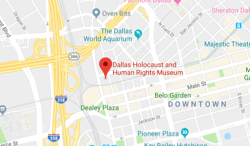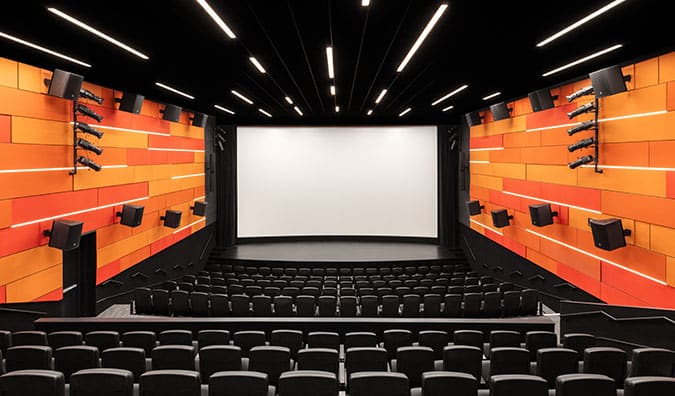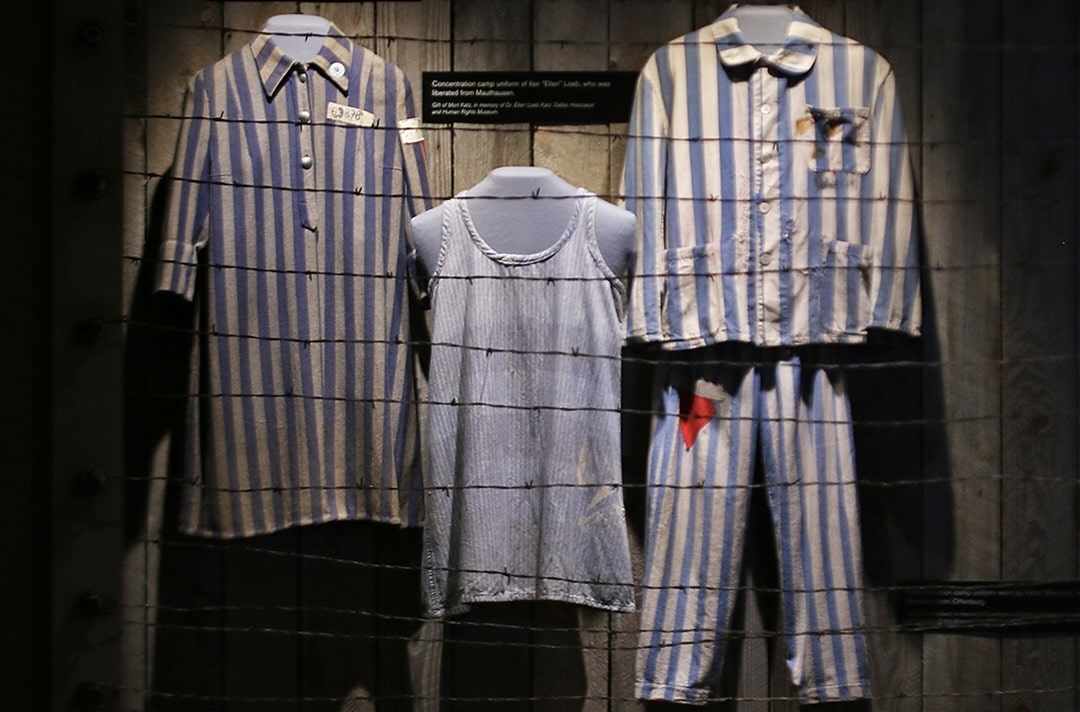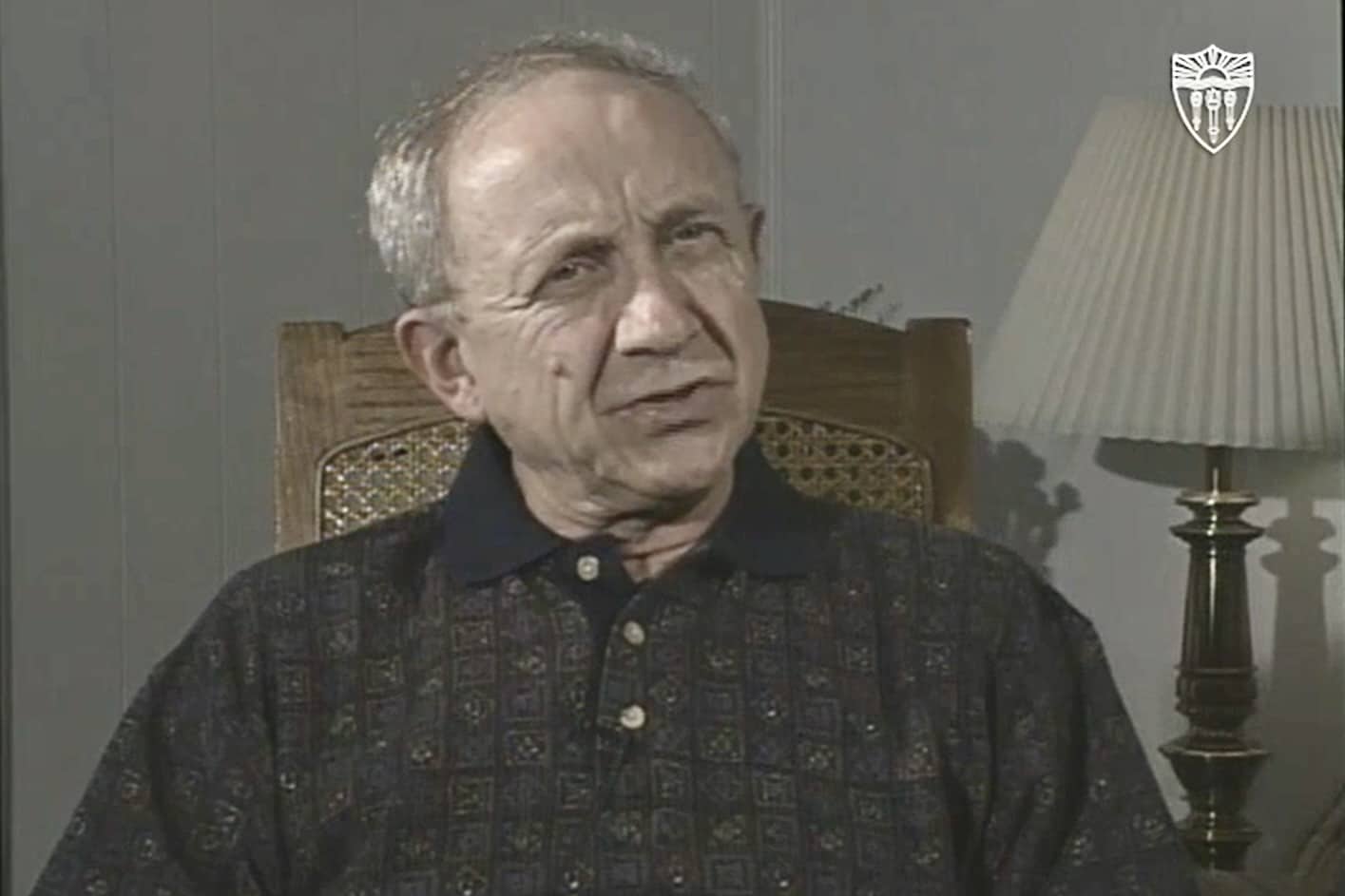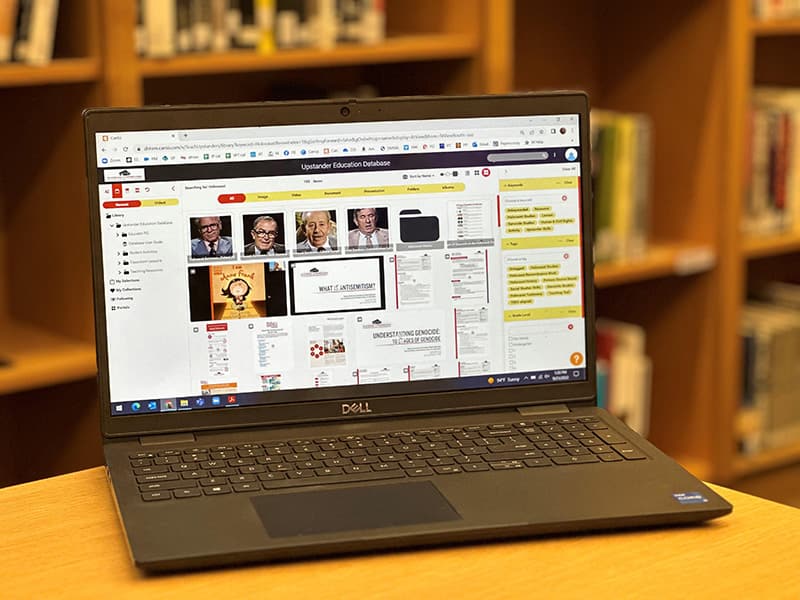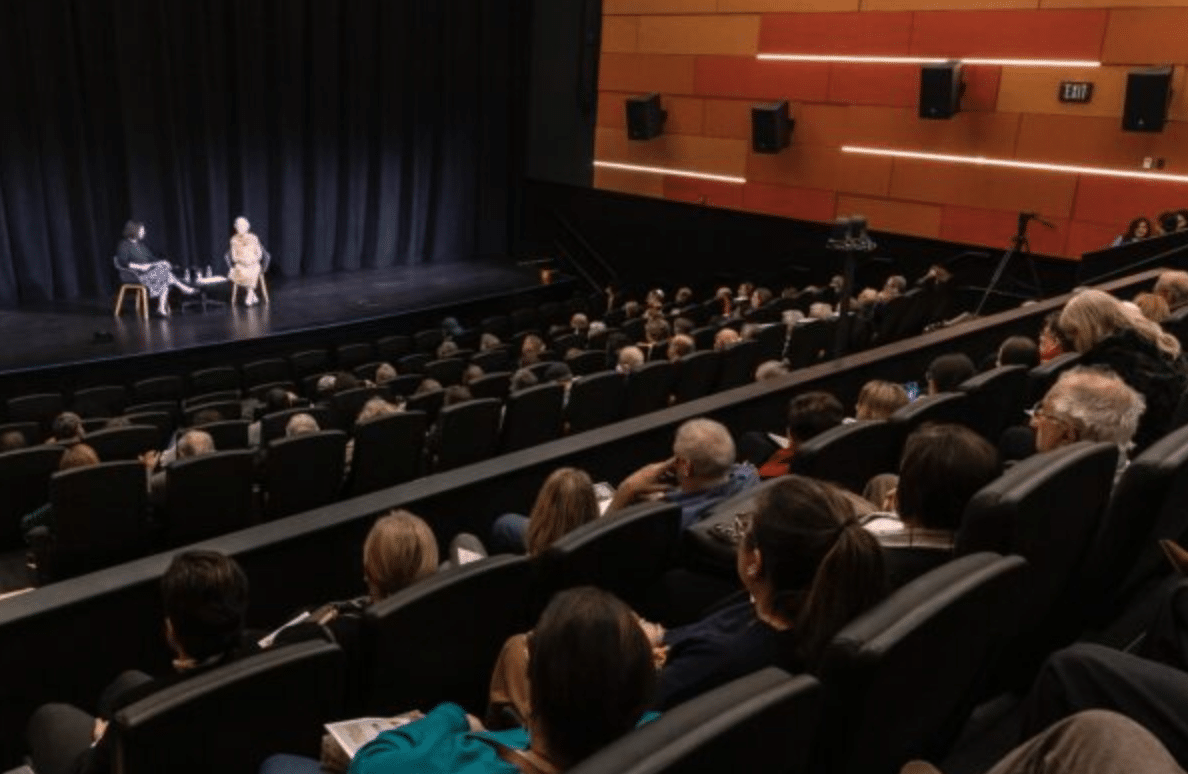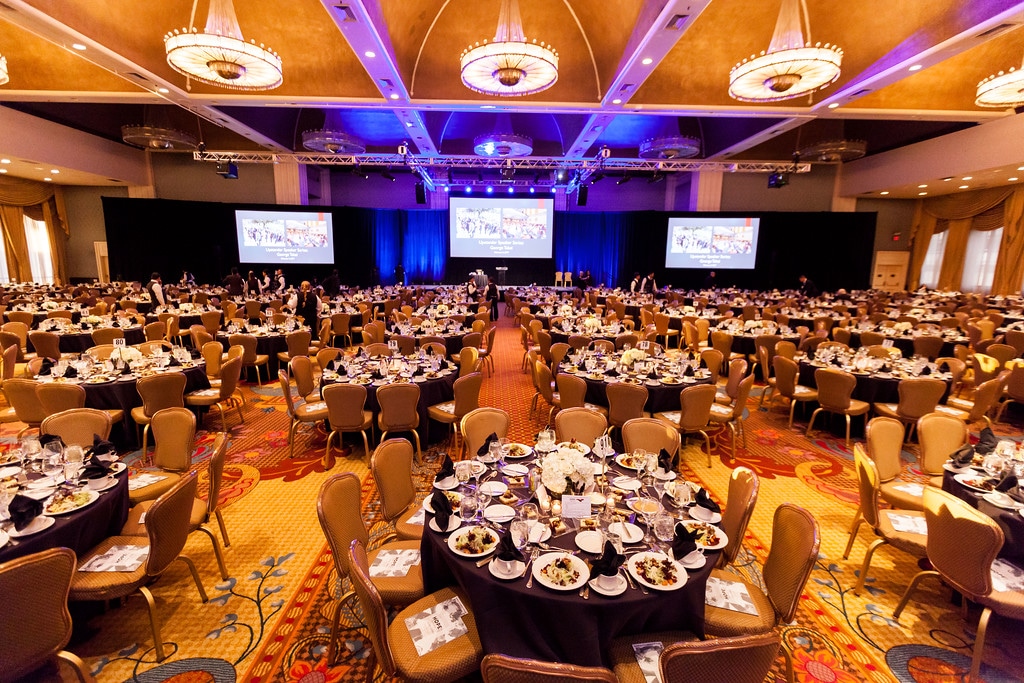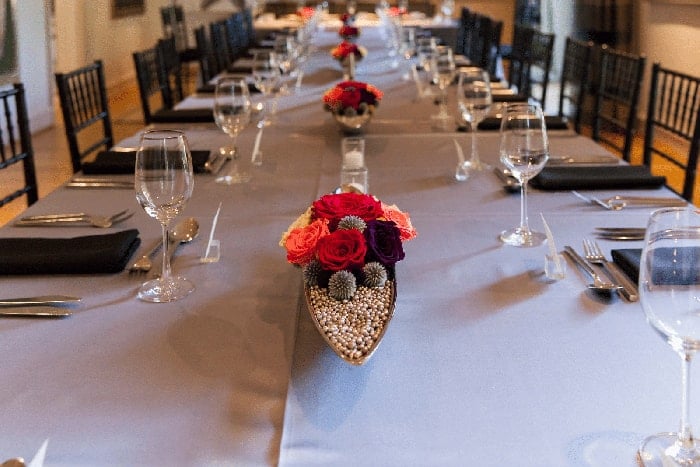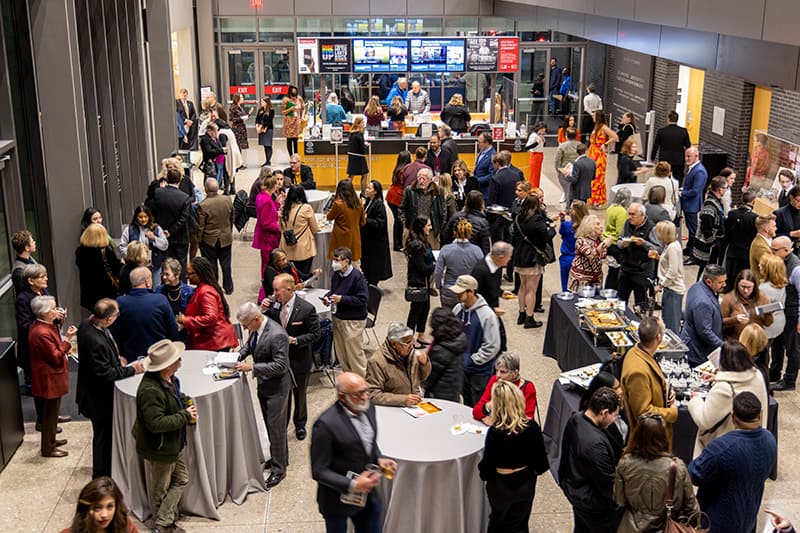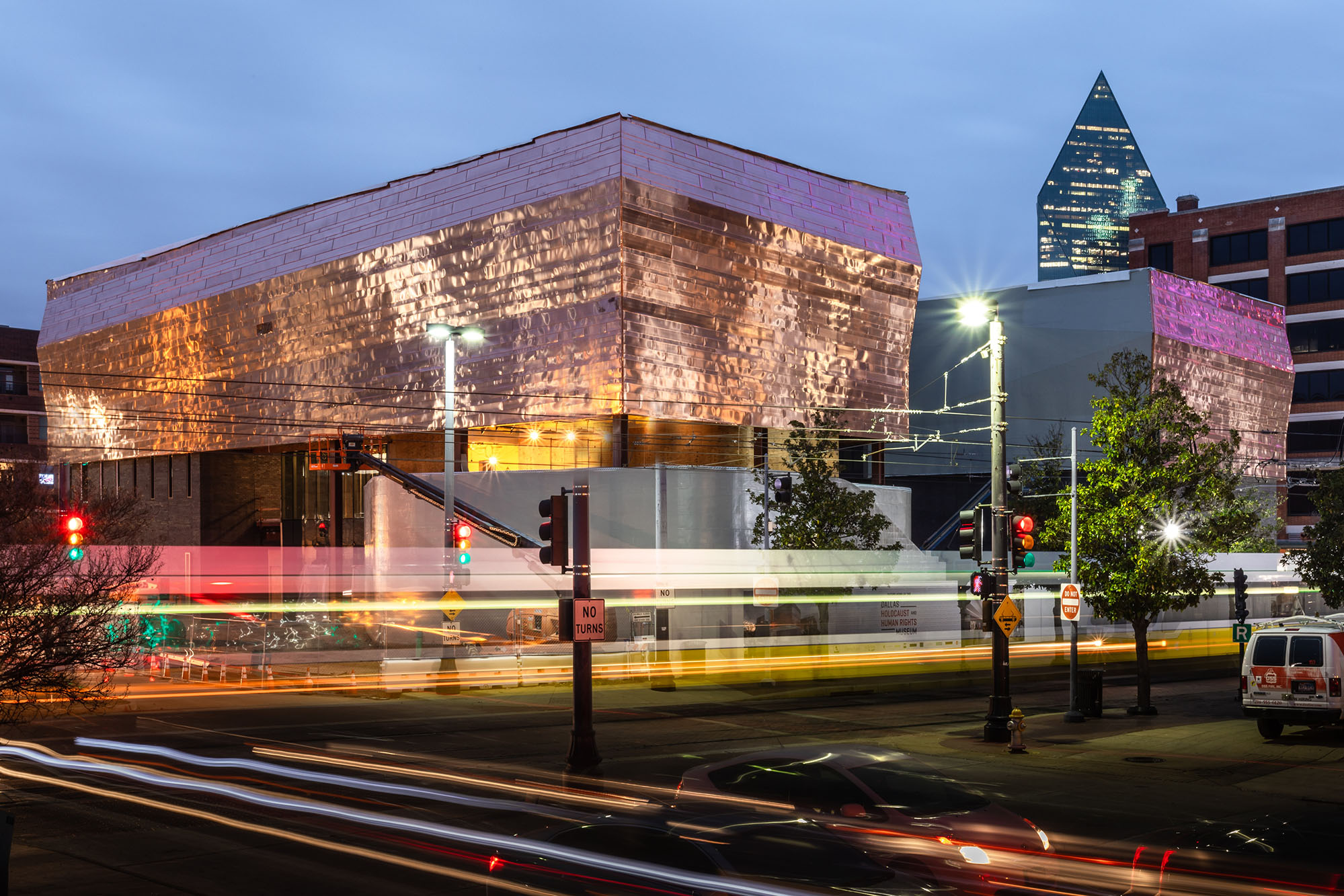Exhibitions
Past Special Exhibition
The Fight for Civil Rights in the South
The Fight for Civil Rights in the South
February 19, 2020 - May 31, 2021
The Fight for Civil Rights in the South combines two prestigious photography exhibitions covering the African American struggle for civil rights and social equality in the 1960s – Selma to Montgomery: Photographs by Spider Martin and Courage Under Fire: The 1961 Burning of the Freedom Riders Bus.
In Selma to Montgomery, photographer James “Spider” Martin captures the iconic march to Montgomery, Alabama in 1965, including the moment when Dr. Martin Luther King, Jr. led more than 2,000 marchers across the Edmund Pettus Bridge. Martin’s photos brought attention to the Civil Rights Movement and documented this nonviolent action that helped lead to the Voting Rights Act of 1965.
Courage Under Fire depicts a peaceful protest met with violence in Anniston, Alabama in 1961. Travelers known as Freedom Riders rode buses into the South to protest segregation on public transportation. On Sunday, May 14, 1961, riders nearly died when their bus was set on fire by members of the Ku Klux Klan. Photographer Joseph Postiglione brought national attention to the violent resistance to desegregation.
The Fight for Civil Rights in the South combines Selma to Montgomery: Photographs by Spider Martin and Courage Under Fire. They are curated and circulated by the Birmingham Civil Rights Institute (BCRI), with contributions from the City of Birmingham and to BCRI’s Corporate Campaign.
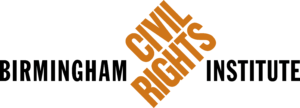
Selma to Montgomery Marches, March 7-25, 1965
James “Spider” Martin was an American photographer known for his work documenting the American Civil Rights Movement in 1965. He was born in Fairfield, Alabama in 1939 and received the nickname “Spider” when a reporter described him as moving “like a spider” during a touchdown celebration at football game. While working as a photographer for The Birmingham News, Martin was assigned to cover the death of Jimmie Lee Jackson in February 1965. One month later, he created a notable photograph of the civil rights era entitled Two Minute Warning during the 1965 Selma Voting Rights Movement. His photograph showed Alabama state troopers about to attack the first peaceful Selma to Montgomery march with batons and tear gas. This incident would later be known as Bloody Sunday.The media coverage of Bloody Sunday catalyzed a national outcry and was influential in the progress of civil rights in the United States. Martin Luther King, Jr. spoke on the effect of photography on the Civil Rights Movement, particularly Martin’s: “Spider, we could have marched, we could have protested forever, but if it weren’t for guys like you, it would have been for nothing.”
Courage Under Fire: Anniston Bus Bombing, May 14, 1961
Joseph Postiglione was an American freelance photographer known for capturing the shocking and memorable photos of the Freedom Riders bus that was attacked and set on fire in Anniston, Alabama on Sunday, May 14, 1961.An aggressive and determined photographer, Postiglione took his camera and followed the mob that intercepted the Greyhound bus. He caught the Freedom Riders in the immediate aftermath, their clothes ashen, their faces distraught, and the flames and smoke from the bus in plain view. Standing at five feet tall, Postiglione made his name easier for readers to pronounce by crediting his photos as “Little Joe” in the captions for his pictures in The Anniston Star. The images made it to the front pages of newspapers around the world and brought international attention to the Civil Rights movement.
Experience the Special Exhibition Virtually!
Click below to view "The Fight for Civil Rights in the South."
VISITOR GUIDE

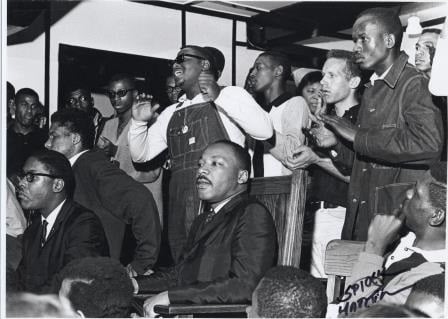
1. Dr. Martin Luther King, Jr., James Forman, and others in the Beulah Baptist Church, Selma, AL, before Bloody Sunday. Selma to Montgomery: Photographs by Spider Martin
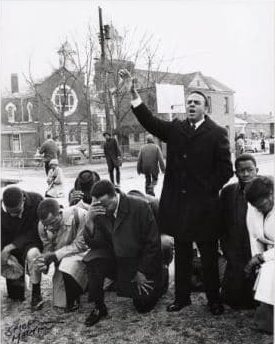
2. Andrew Young leads marchers in prayer outside Brown Chapel AME Church, Selma, Alabama. Selma to Montgomery: Photographs by Spider Martin
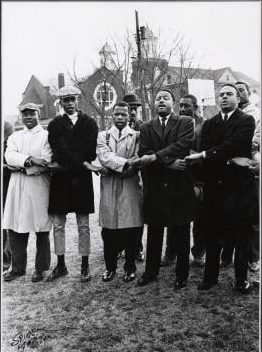
3. Bob Mants, John Lewis, Hosea Williams, Albert Turner, and Andrew Young with other marchers outside Brown Chapel AME Church, Selma, AL. Selma to Montgomery: Photographs by Spider Martin
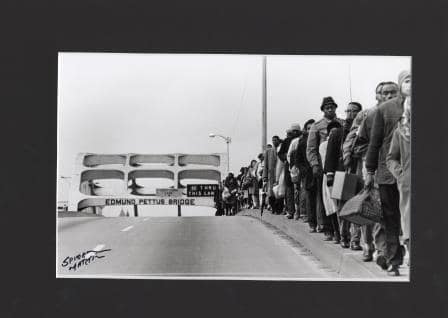
4. Marchers pass over the Edmund Pettus Bridge in Selma, AL. Selma to Montgomery: Photographs by Spider Martin
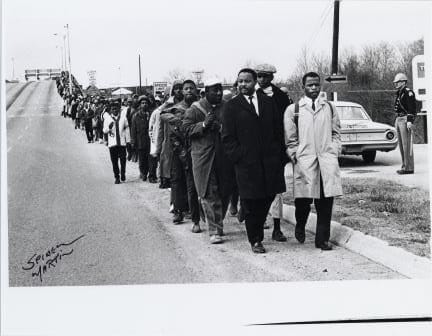
5. John Lewis, Hosea Williams, Albert Turner and Bob Mants lead marchers beyond the bridge.
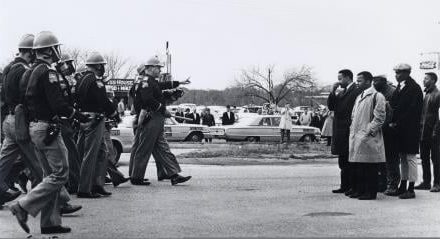
6. Hosea Williams, John Lewis, Albert Turner, and Bob Mants confront state troopers on Bloody Sunday.
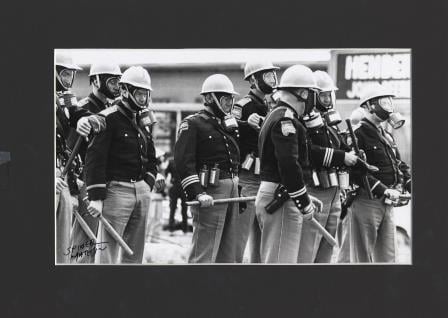
7. Alabama state troopers, equipped with gas masks, tear gas, and clubs, await marchers beyond the Edmund Pettus Bridge.
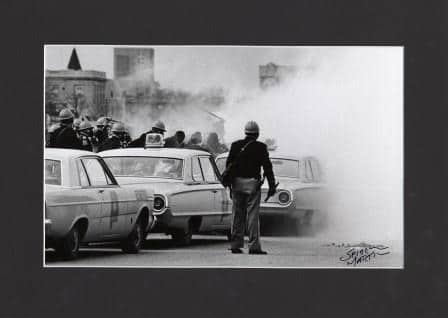
8. Tear gas released beyond the bridge by state troopers.

9. Marchers are beaten by Alabama state troopers on Bloody Sunday, March 7, 1965.

10. Selma activist Amelia Boynton, injured by state troopers, falls in the median of Highway 80 near the Edmund Pettus Bridge.
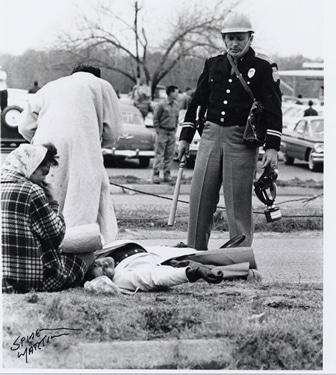
11. Amelia Boynton lies on the ground as a state trooper stands over her.
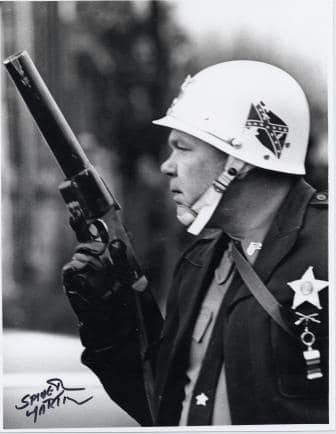
12. A Dallas County, AL, sheriff's deputy with a tear gas launcher.
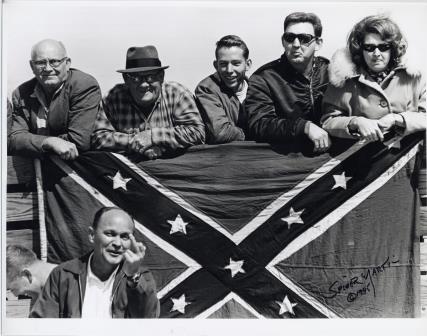
13. Hecklers abuse marchers from behind a Confederate flag.
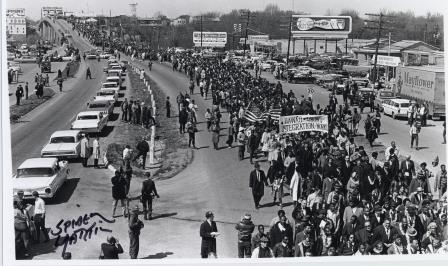
14. Wide view of marchers and the Edmund Pettus Bridge, Selma, AL.
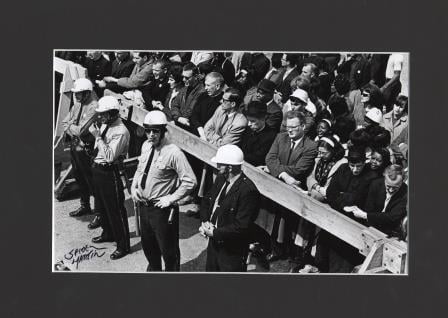
15. Members of the clergy and representatives of many faith communities answered Dr. King's call and flew to Alabama from across the nation to participate in the Voting Rights March.
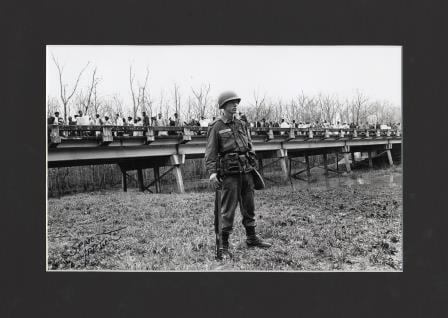
16. U.S. Army soldier stands guard as marchers.
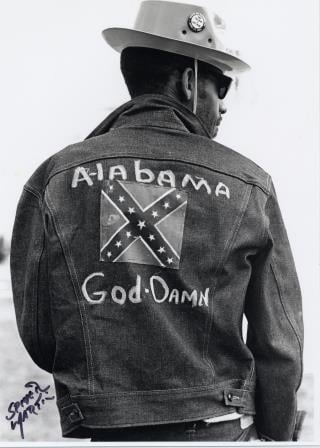
17. An unidentified man on the Selma to Montgomery march wears a jacket painted to express his sentiments.
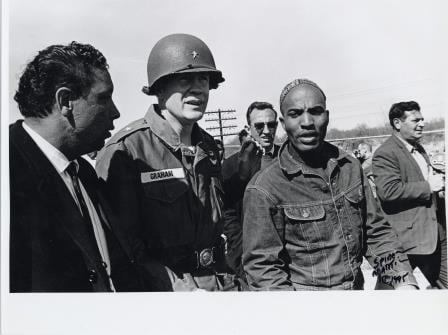
18. Alabama National Guard Brigadier General Henry Graham escorts James Bevel on the road from Selma to Montgomery.
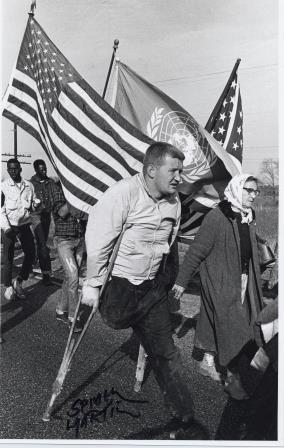
19. Jim Leatherer, with one leg, marches on crutches, completing the entire journey from Selma to Montgomery.
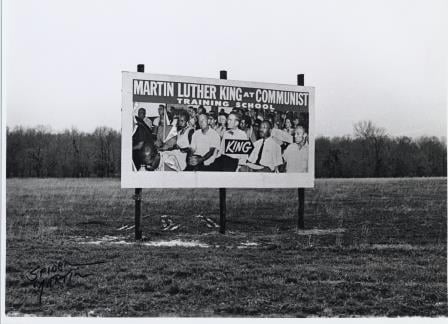
20. A billboard along the march suggests that Dr. King attended a Communist training school.
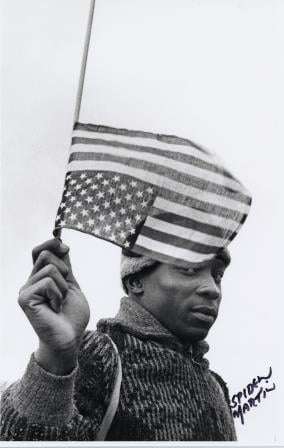
21. A marcher protesting segregation positions his U.S. flag upside-down to signal distress.
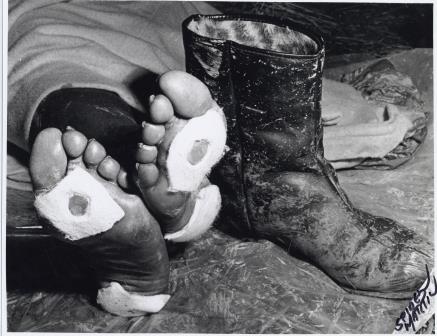
22. A marcher's blistered feet after forty miles.
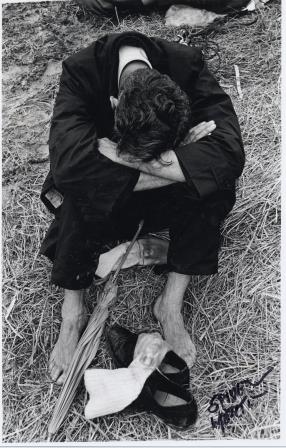
23. A Pastor from Maine, exhausted, rests before continuing the march from Selma, AL to Montgomery, AL.
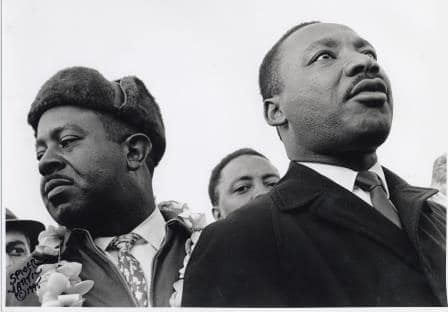
24. Martin Luther King, Jr. and Ralph David Abernathy on the first day of the march from Selma to Montgomery.
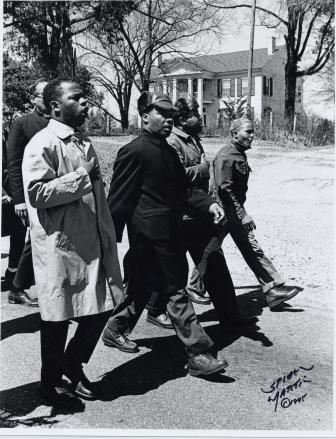
25. John Lewis, Martin Luther King, Jr., Ralph David Abernathy, and James Bevel on the road from Selma to Montgomery.
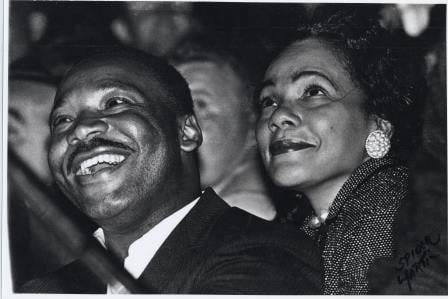
26. Dr. Martin Luther King, Jr. and Coretta Scott King laugh during entertainment at the St. Jude Hospital in Montgomery, AL on the night before the march to the Capitol.
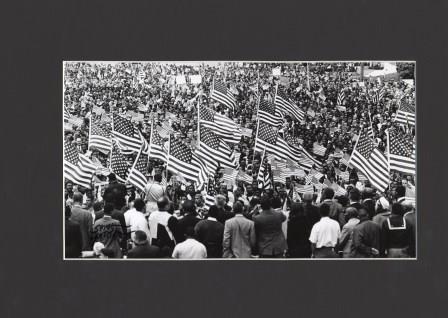
27. Waving flags at the Alabama State Capitol, Montgomery, AL.

28. Dr. and Mrs. King lead the march through downtown Montgomery, AL.
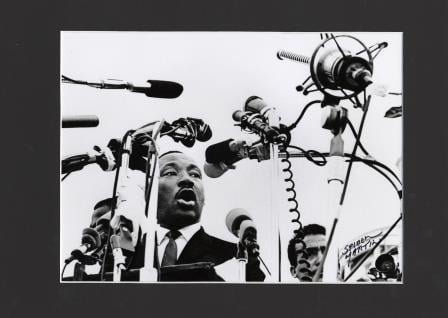
29. Dr. King speaks into a web of microphones.
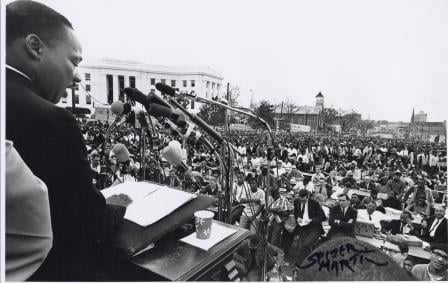
30. Dr. King speaks to a crowd of more than 20,000 at the end of the march.
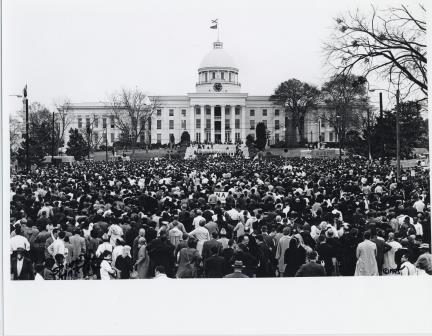
31. A crowd of 25,000 gathered at the Alabama State Capitol.

32. A marcher rests under armed protection.
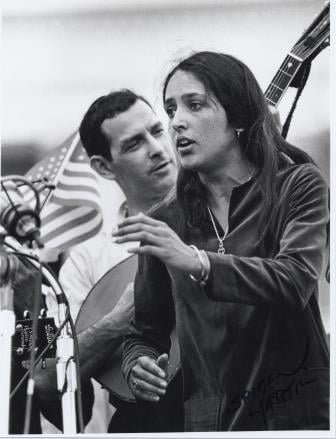
33. Singer Joan Baez sings to inspire the crowd at the conclusion of the march from Selma to Montgomery.

34. Dr. King with Ralph Abernathy, James Forman, and Rev. Jessie Douglas as they lead marchers around the Alabama State Capitol in Montgomery.

35. Law enforcement officers investigate the scene of the murder of Viola Liuzzo along Highway 80 in Lowndes County, AL. Liuzzo, a white woman and mother of 5 from Detroit, was shot and killed by segregationists as she drove a young black man from Montgomery to his home in Selma on the night the march ended.

36. Alabama Governor George C. Wallace.

37. Montgomery segregationist Shorty Price leads a protest against the march and Dr. King outside the Alabama State Capitol.
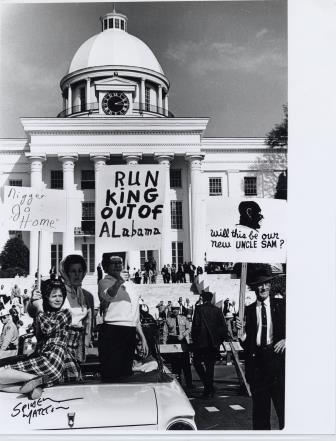
38. White protesters outside the State Capitol in Montgomery, AL
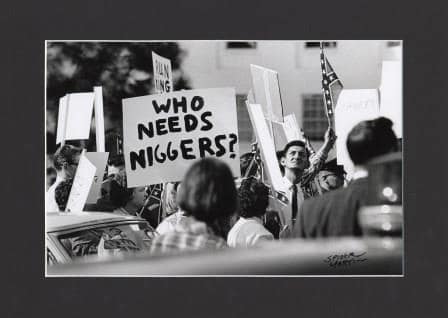
39. White protesters outside the State Capitol in Montgomery, AL
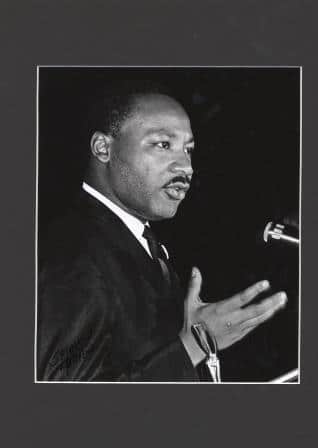
40. Dr. Martin Luther King, Jr. speaking in Birmingham, AL after Congress passed the Voting Rights Act in August 1965. On the occasion, King thanked Spider Martin for capturing images that drew the nation's attention to the Civil Rights Movement.
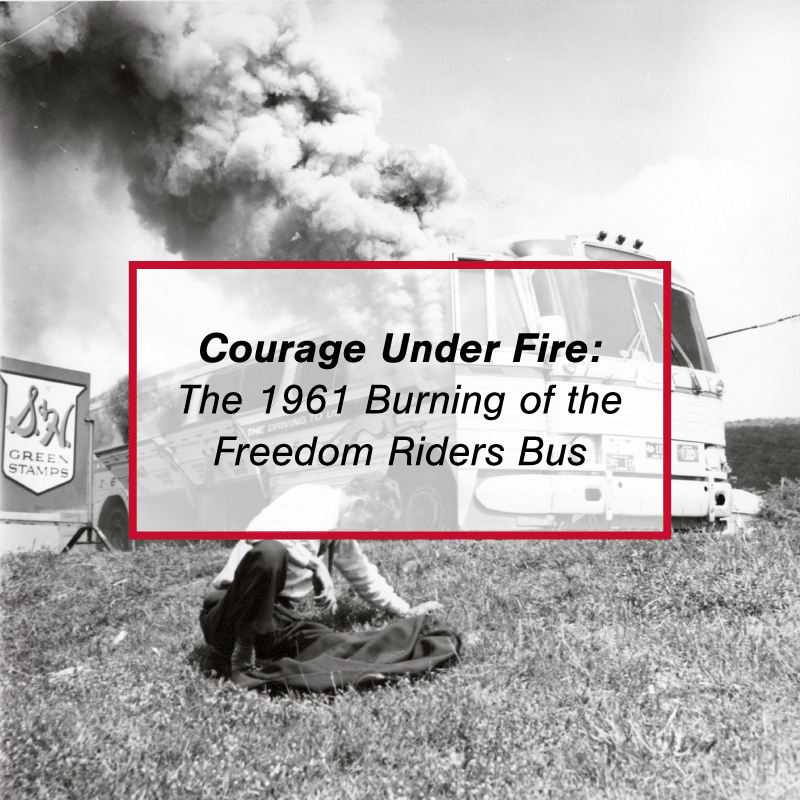
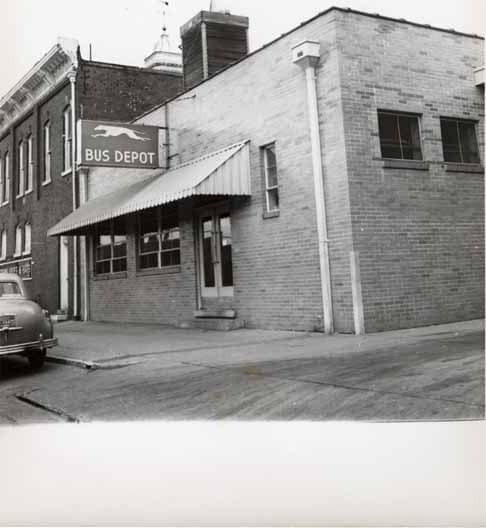
41. Greyhound Bus Depot , Anniston, AL.
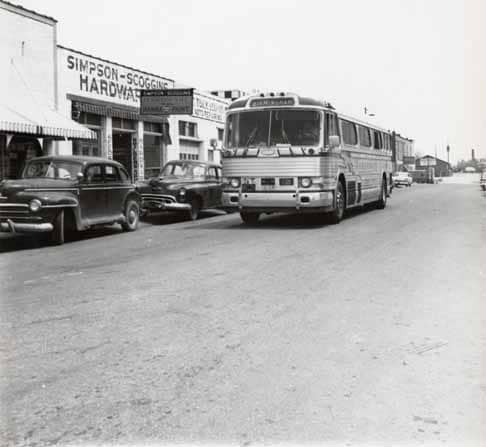
42. Freedom Riders Bus arriving in Anniston on the way to Birmingham, AL.
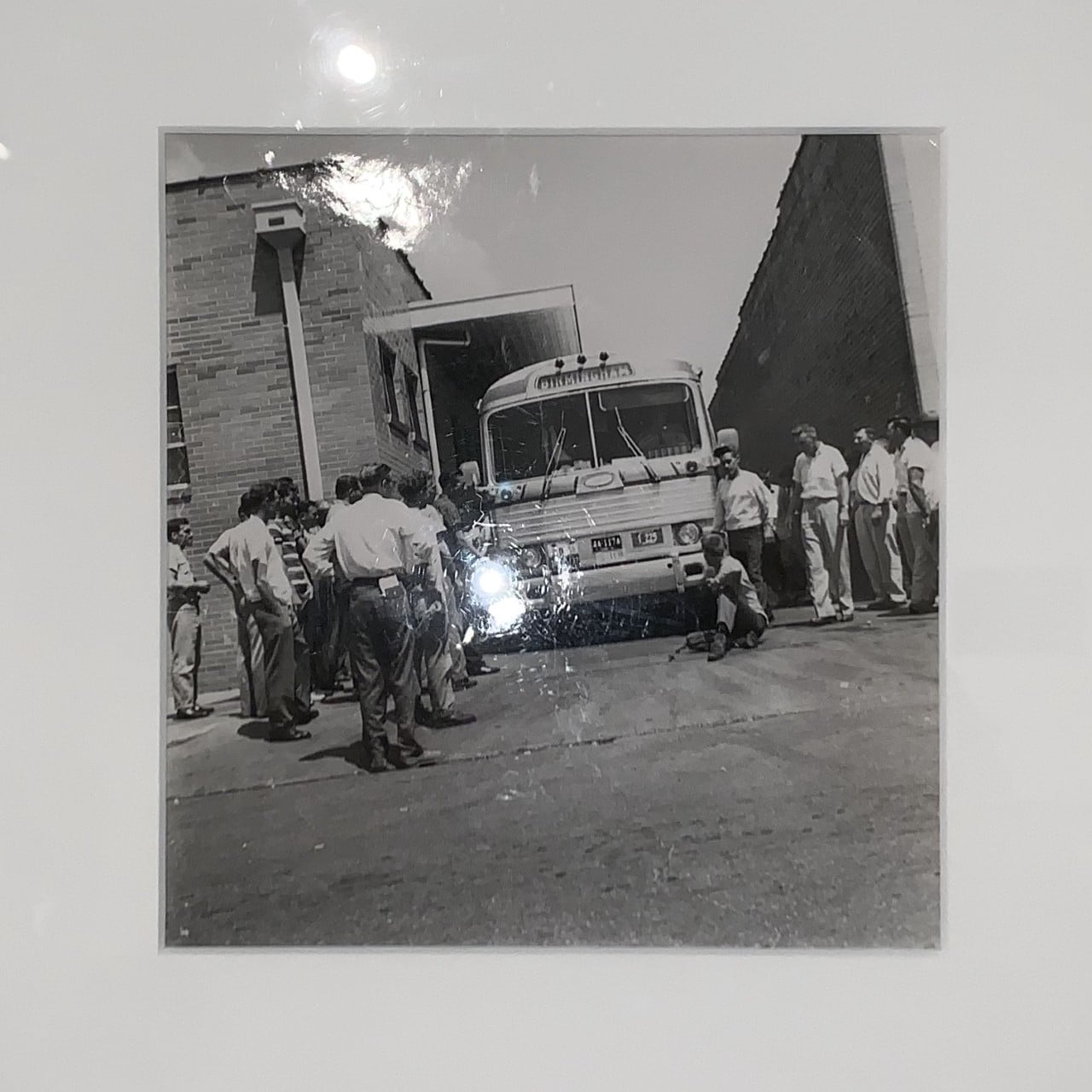
43. Ku Klux Klan member sitting on pavement, preparing to lie in front of Freedom Riders Bus to keep it from leaving.

44. A crowd of Ku Klux Klan members eyeing the Freedom Riders Bus at the deliberately closed bus depot in Anniston, AL.
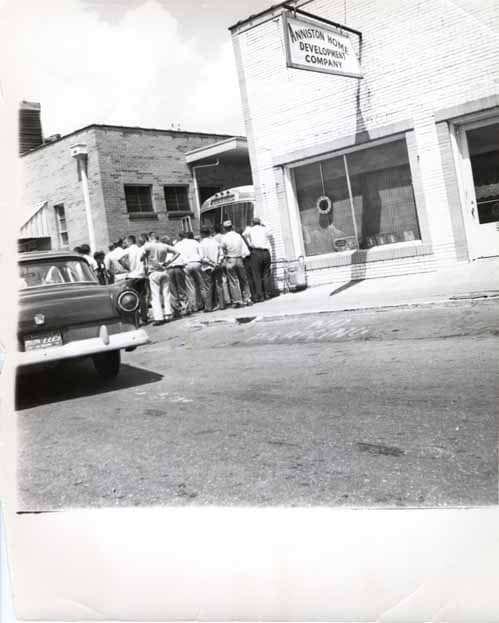
45. A crowd of Ku Klux Klan members threatening the Freedom Riders Bus at the closed bus depot in Anniston, AL. They smash windows and slash two of the bus's tires.
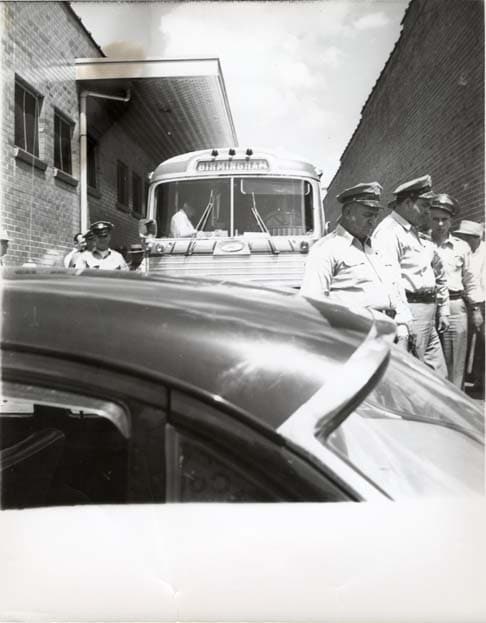
46. After first refusing to assist, police clear a path so the Freedom Riders Bus can depart the bus depot in Anniston, AL.
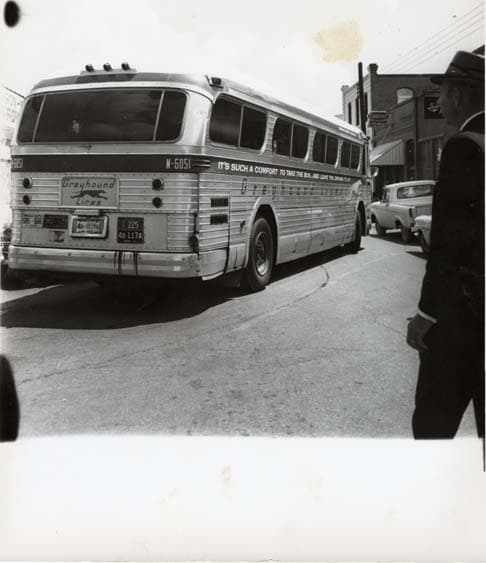
47. Freedom Riders Bus leaving the bus depot.
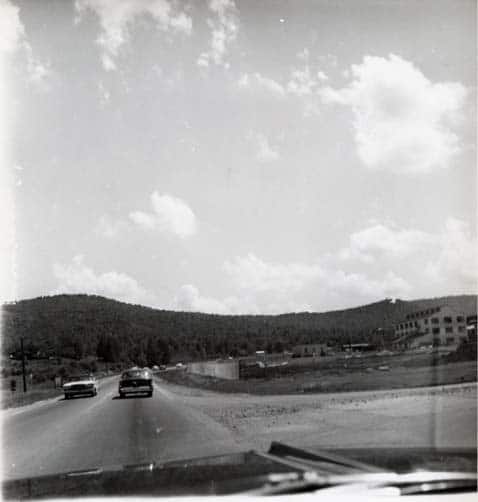
48. View of the road on the outskirts of Anniston, AL.

49. Greyhound bus driver inspecting a slashed flat tire on the Freedom Riders Bus outside Anniston, AL. The bus was surrounded by cars and trucks that followed it out of town.
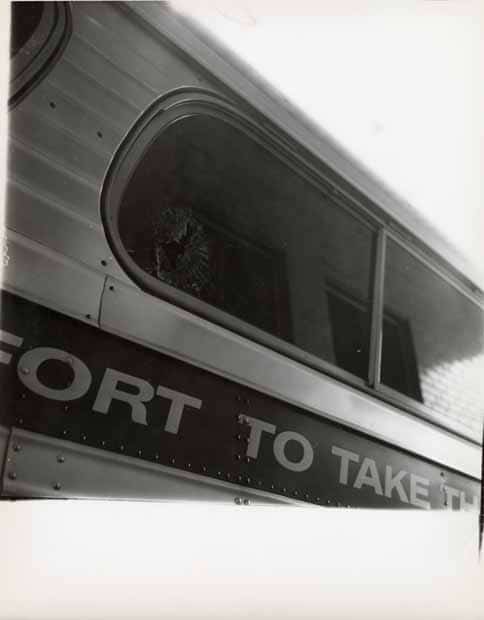
50. Window photo of the Freedom Riders Bus.
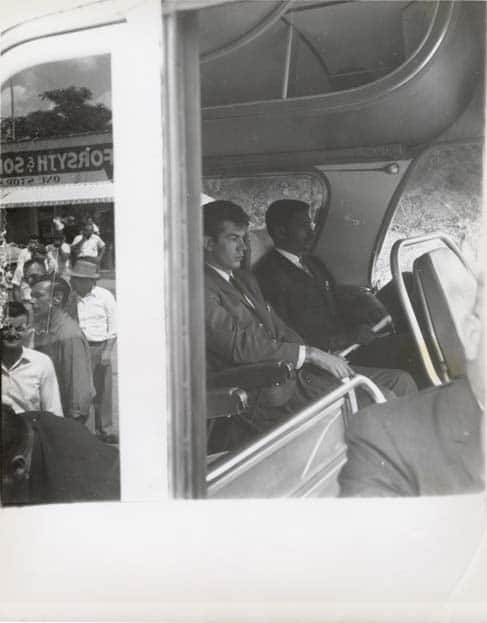
51. Freedom Riders remain on the bus while an angry white crowd from Anniston is reflected in the bus window. The crowd yells racist taunts at the Riders and continues to pound on the outside of the bus.
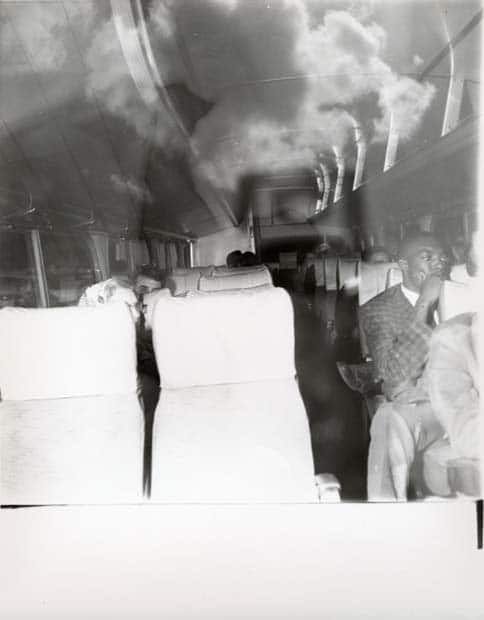
52. Photo of Freedom Riders from the front of the bus. Smoke from a bundle of burning rags tossed through a smashed window by two Klansmen is visible.
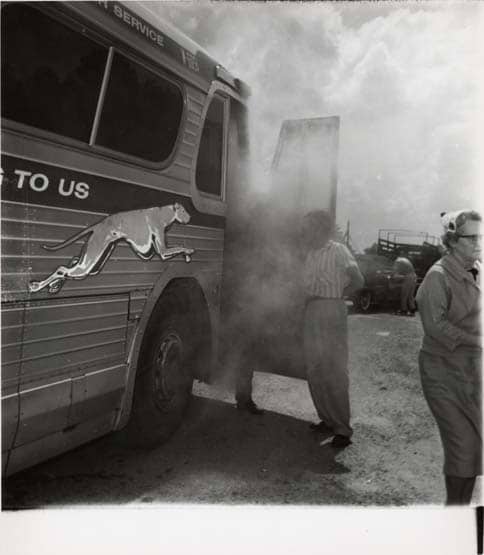
53. Smoke billows out of the bus after the burning rags explode inside. The bus is still surrounded by an angry white crowd from Anniston, AL, yelling racist taunts and hitting the outside of the bus. This keeps the Freedom Riders from leaving the increasingly smoke- and flame-filled bus.
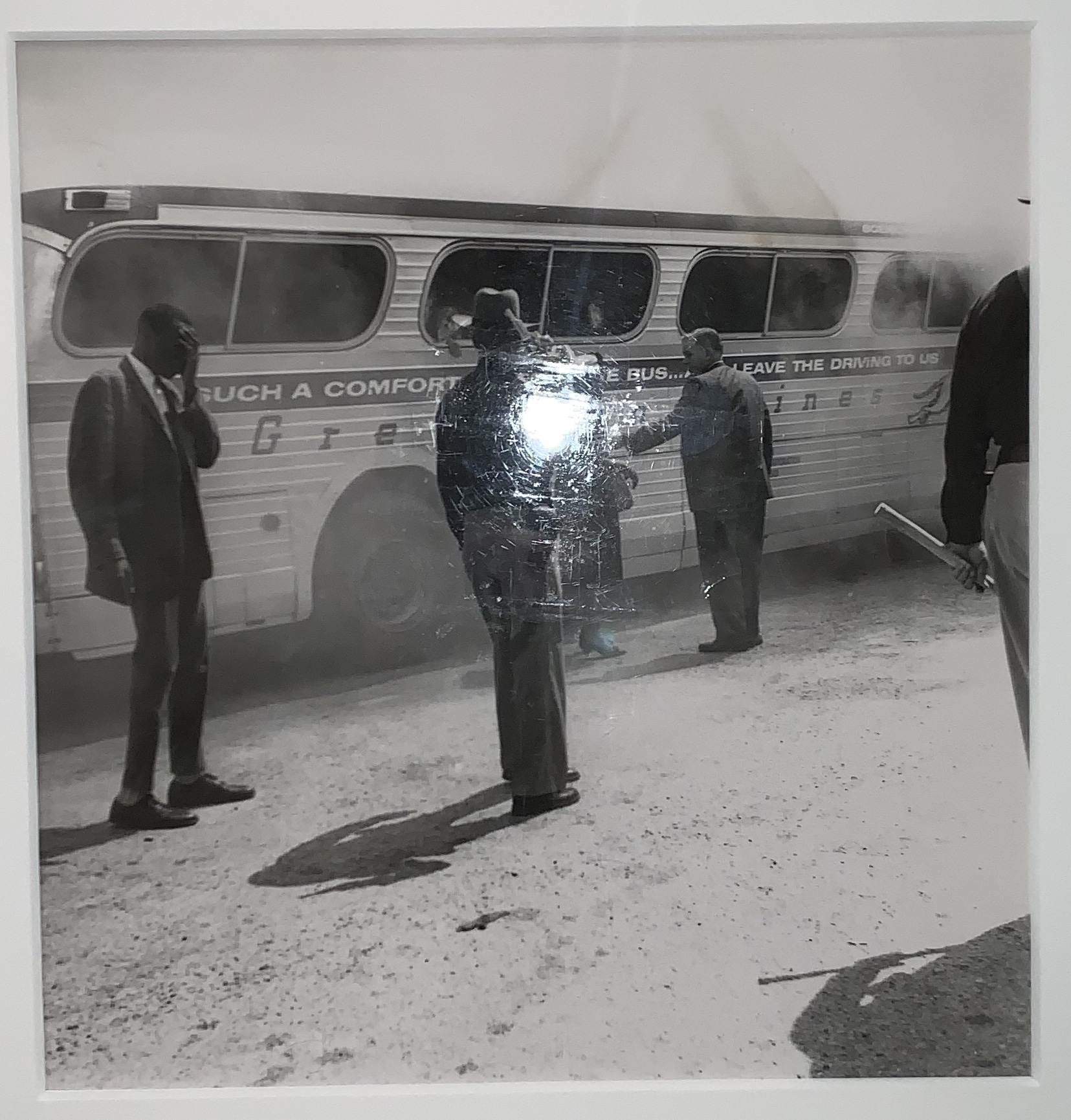
54. As the bus continues to burn, an African American Freedom Rider, a plainclothes policeman, and a police officer stand by its side. The mob begins to disperse as another explosion occurs and a policeman fires his pistol in the air. A few local whites help the Riders, bringing them water and comforting them. These locals were later threatened by their neighbors for the assistance they gave.

55. The Freedom Riders Bus continues to burn.
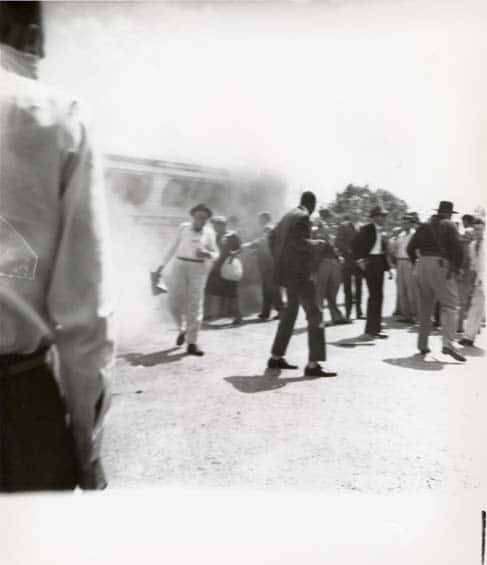
56. A fuel tank explodes, driving the Freedom Riders off the bus through the front door and side windows. The hostile crowd, afraid there will be another explosion, backs away from the bus. The first Freedom Rider off the bus, a black student named Henry "Hank" Thomas, is hit in the head by a man wielding a baseball bat. Thomas collapses as other Freedom Riders flee the burning bus.
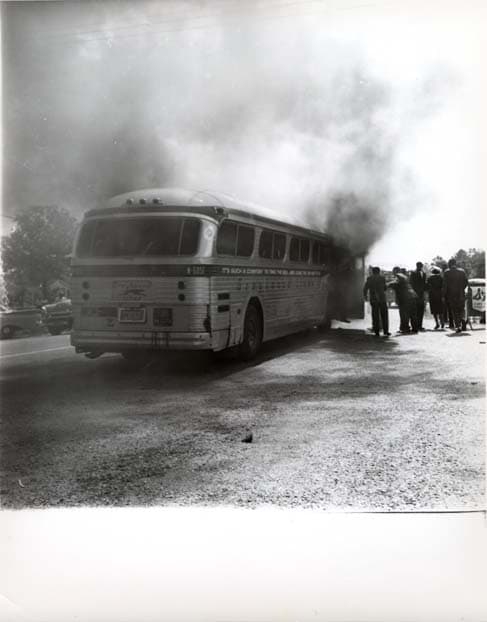
57. View from behind the burning bus with passengers continuing to disembark.

58. View of the side of the burning bus with three Freedom Riders on the right side of the photo.
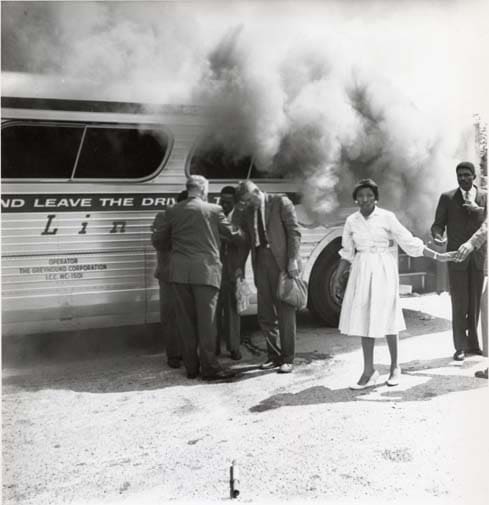
59. Freedom Riders Bus on fire with Freedom Rider Mae Frances Moultrie Howard standing by its side.
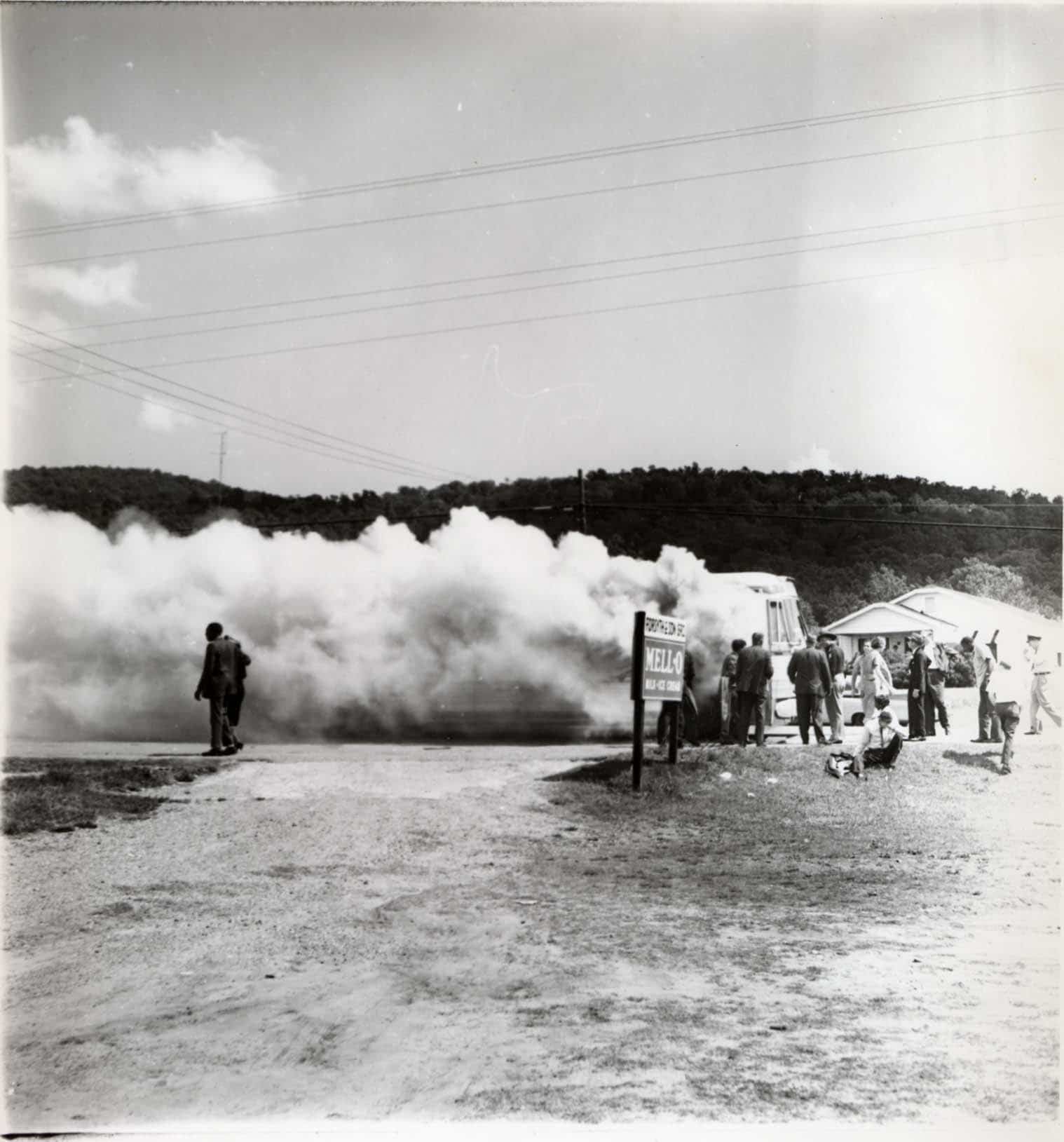
60. Long shot of the burning bus with Freedom Riders and others standing by its side. The Forsyth & Son Grocery/gas station is also visible.
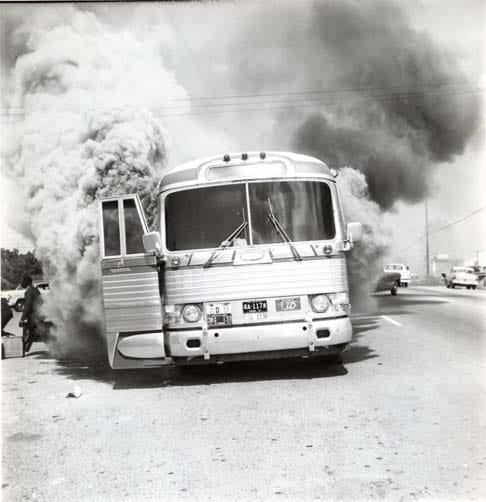
61. Front view of the burning Freedom Riders bus with Freedom Riders carrying their luggage on the left.
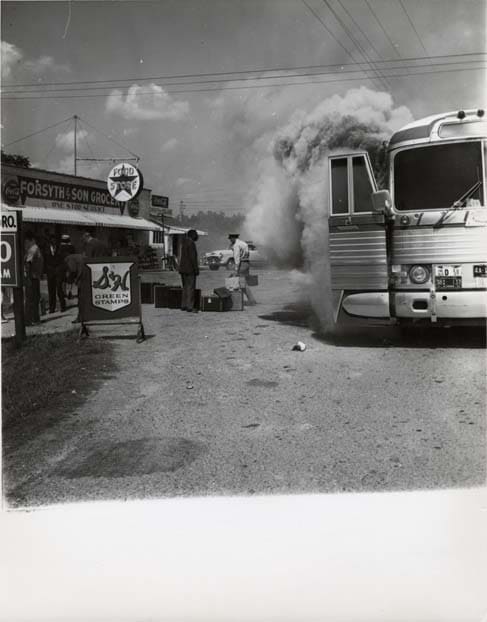
62. Greyhound bus driver unloading Freedom Rider suitcases from the burning vehicle at the Forsyth & Son Grocery/gas station.

63. The unloaded bus burning at the side of the road with a Freedom Rider resting on the ground.
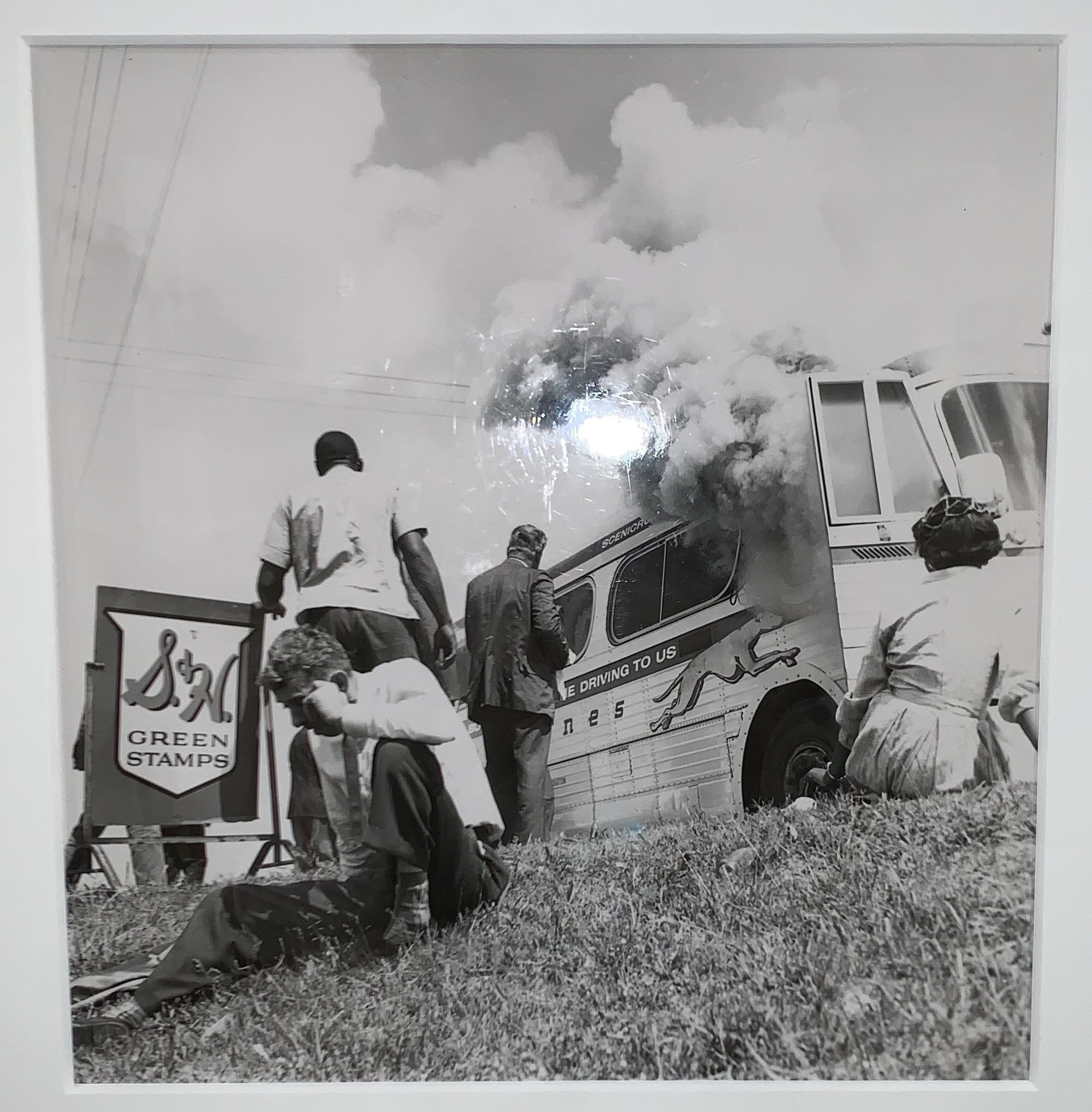
64. Closeup of the burning bus with Freedom Riders and others standing by its side.
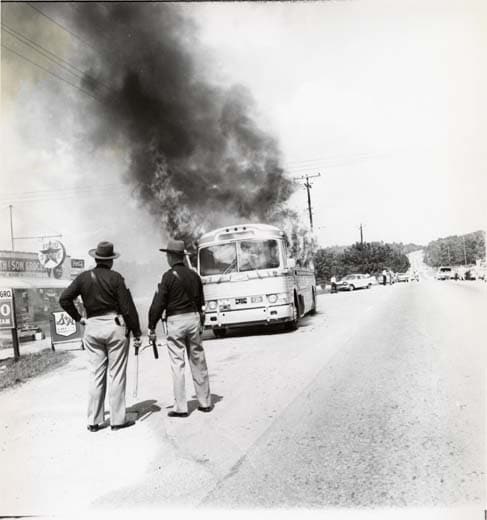
65. Police patrolmen stand guard in front of the burning bus.
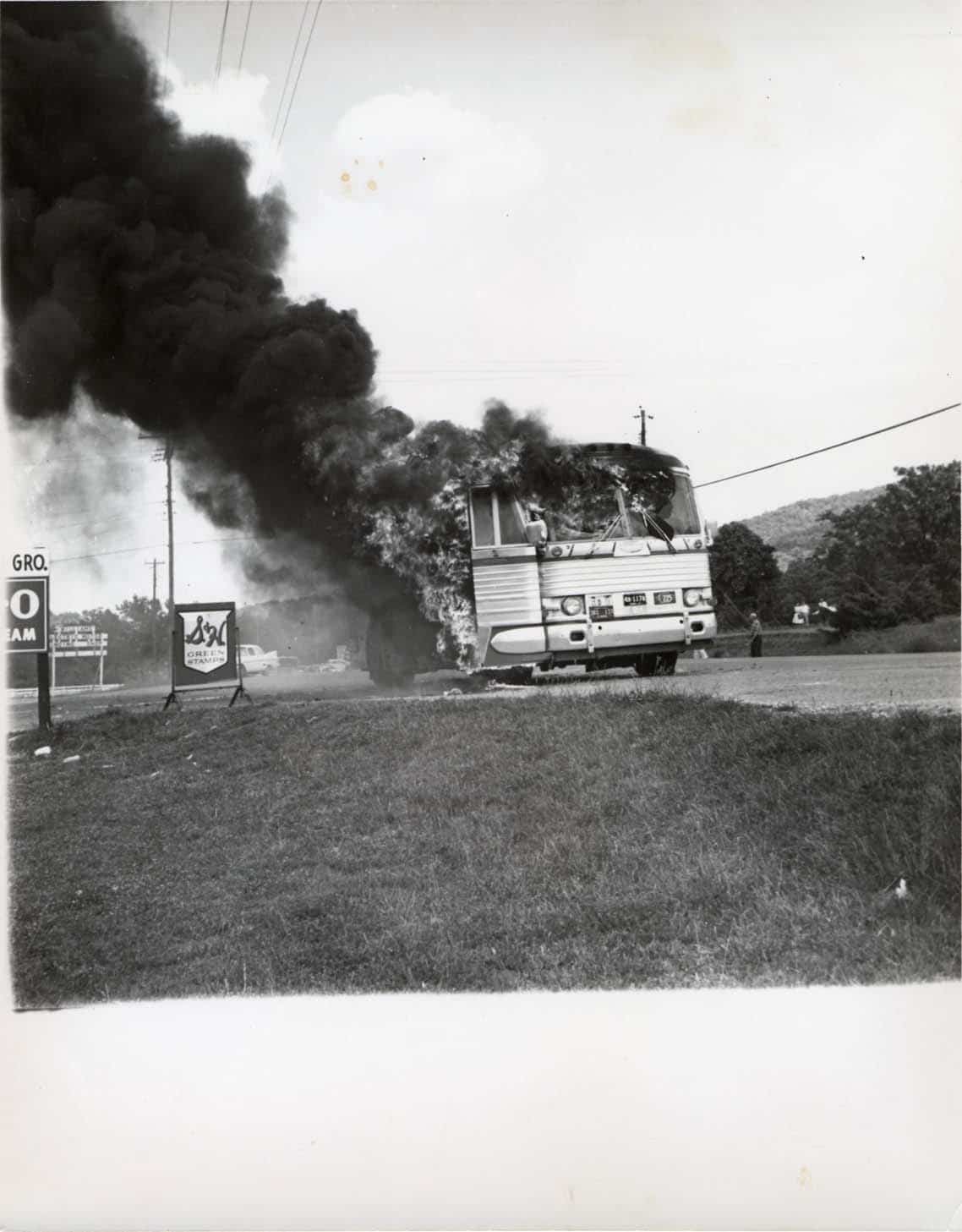
66. Flames and smoke billow from the empty burning bus.

67. The Freedom Riders Bus continues to burn on the outskirts of Anniston, AL.
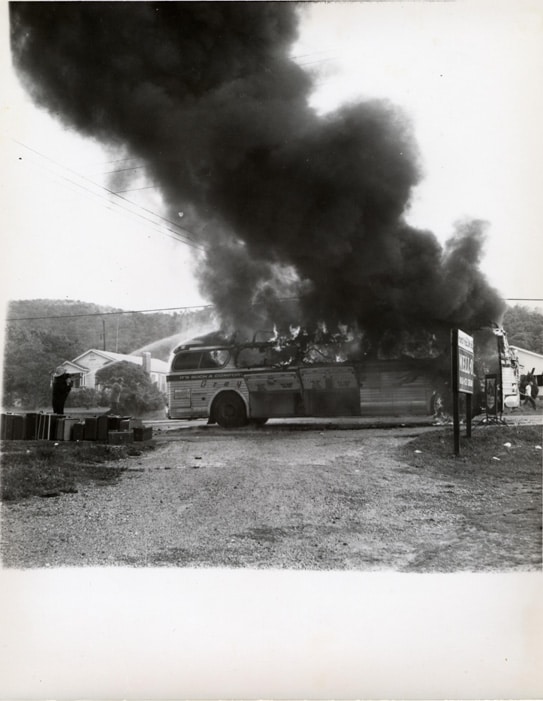
68. The Freedom Riders Bus continues to burn. A fireman, at far left, attempts to put out the fire.
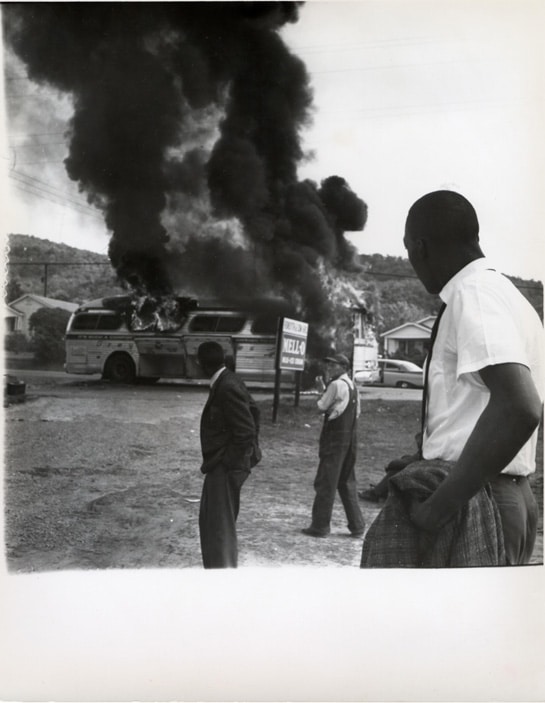
69. Two Freedom Riders and a local onlooker stand a short distance from the burning bus.
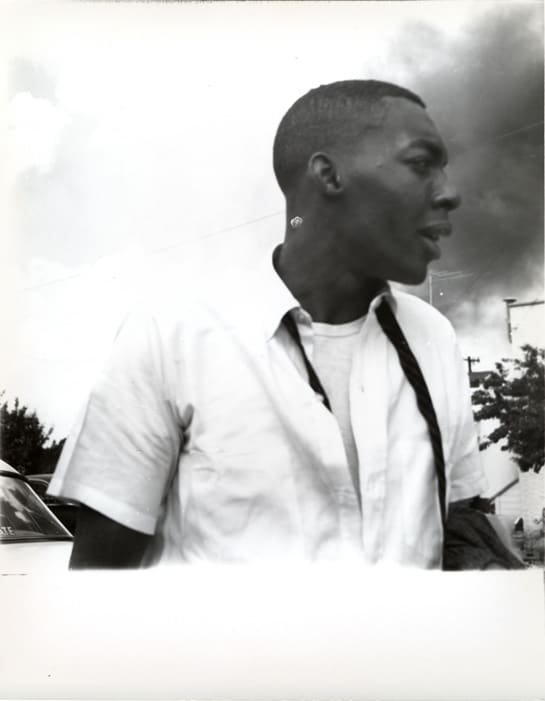
70. Henry "Hank" Thomas stands near the burning bus.
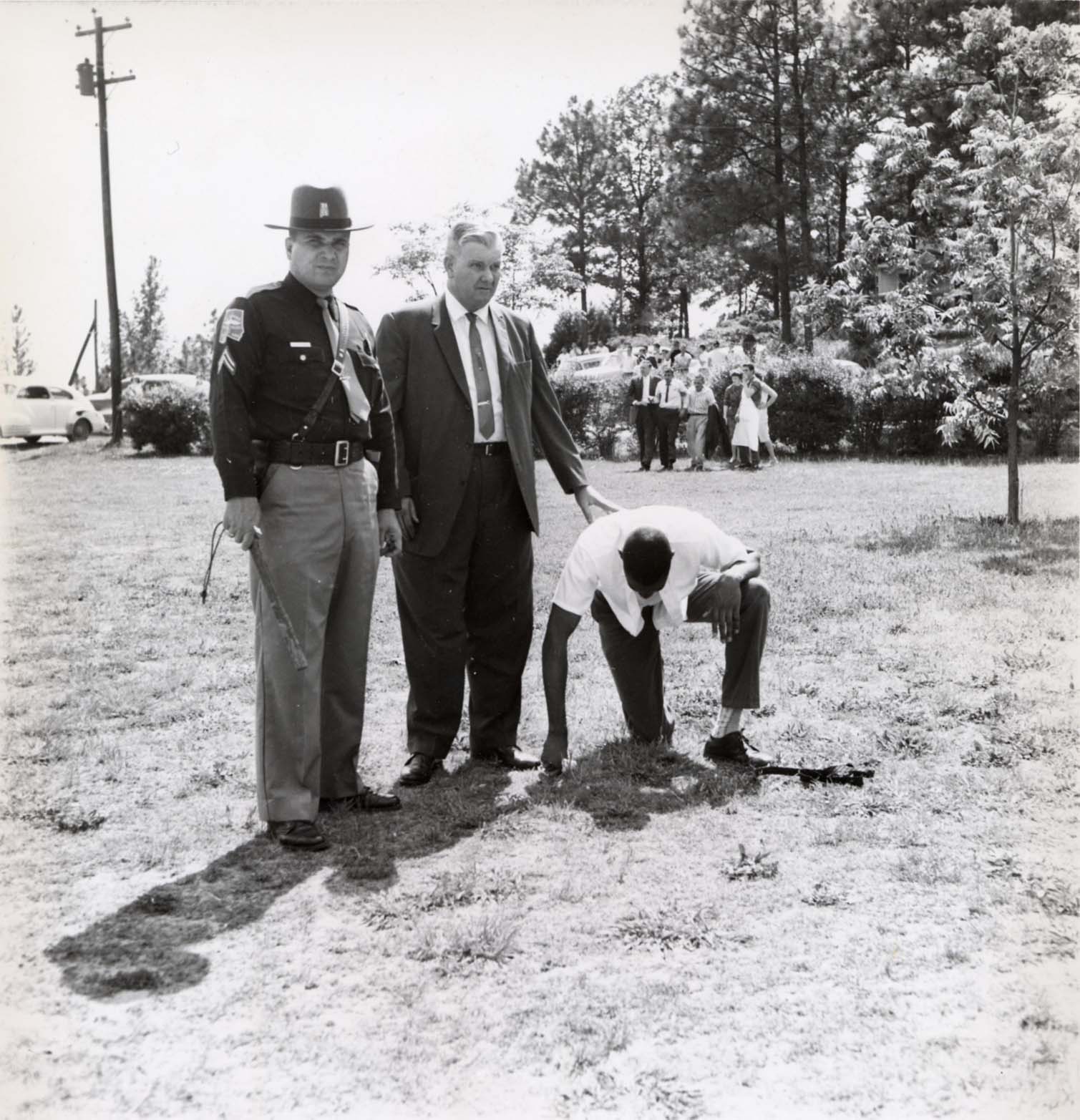
71. A policeman and a plainclothes officer stand next to Hank Thomas, who has been clubbed in the head by a member of the crowd.
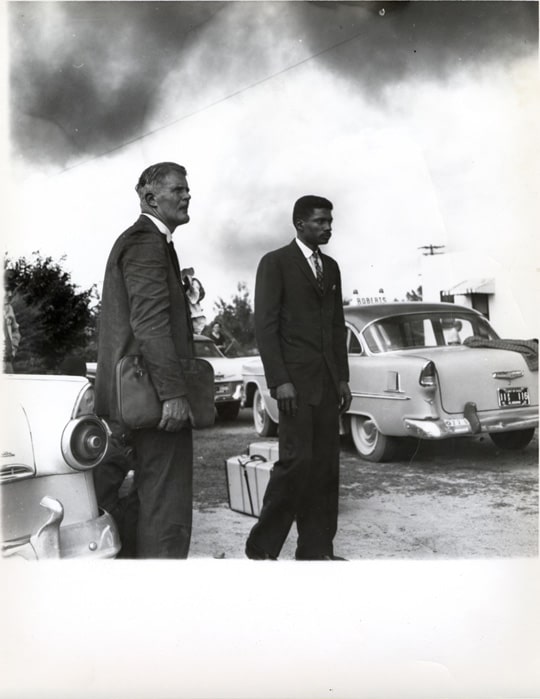
72. Albert Bigelow and Joseph Perkins with their luggage.
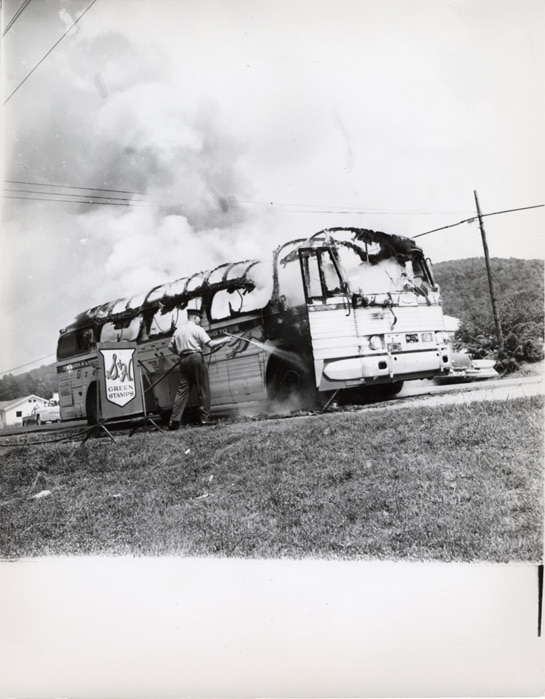
73. A fireman attempts to put out the flames on what remains of the Freedom Riders Bus.

74. Close up of Freedom Riders, suffering from smoke inhalation, with an ambulance official helping them (in hat).
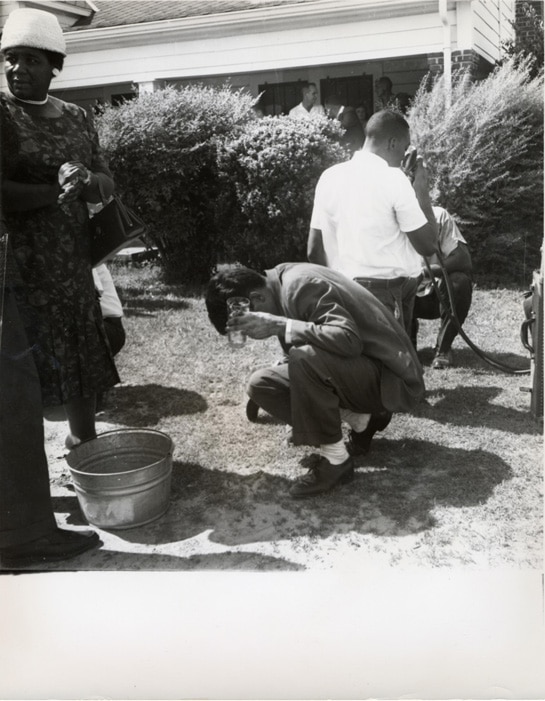
75. Closeup of recovering Freedom Riders suffering from smoke inhalation.
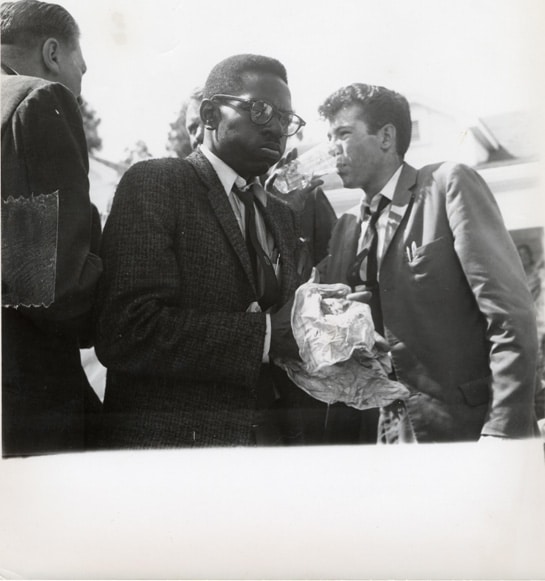
76. John Lewis and Edward Blankenheim recovering from smoke inhalation.
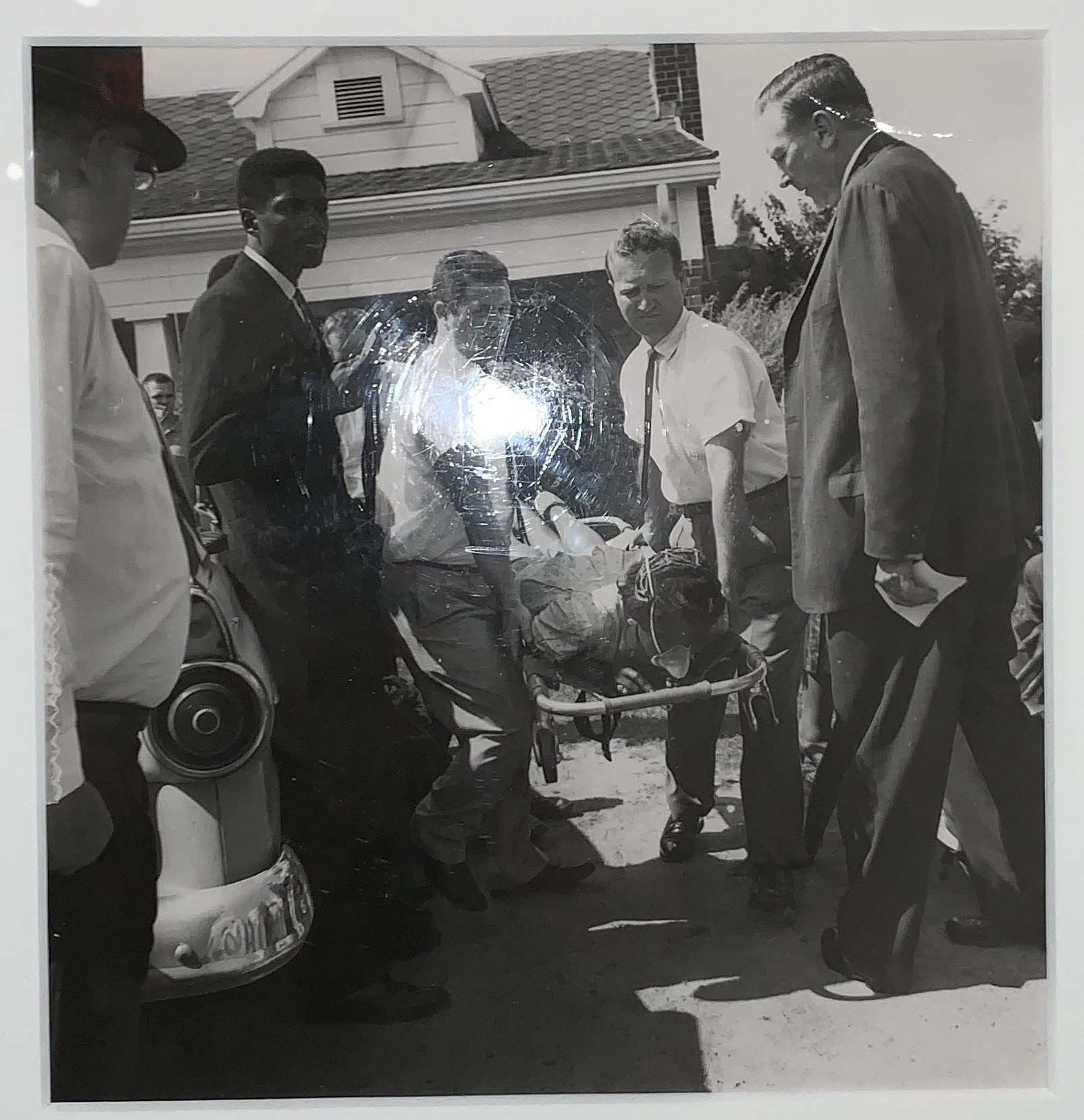
77. An injured Freedom Rider is loaded into an ambulance on a gurney. The ambulance transported both black and white injured Riders, over the initial objections of the driver.
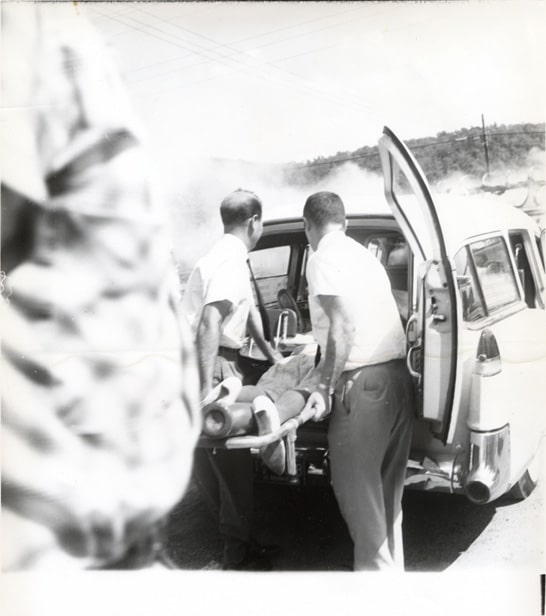
78. A Freedom Rider is checked in an ambulance before being transported to Anniston Memorial Hospital, where they were met with hostility and told to leave before nightfall. lin response, eight cars, driven by deacons, drove out from Birmingham, AL at the direction of Rev. Fred Shuttlesworth, one of the organizers of the Freedom Rides. They loaded up the Riders at the hospital and drove in a convoy back to Birmingham. Several of the deacons were armed with shotguns, just in case they had to fight their way out.
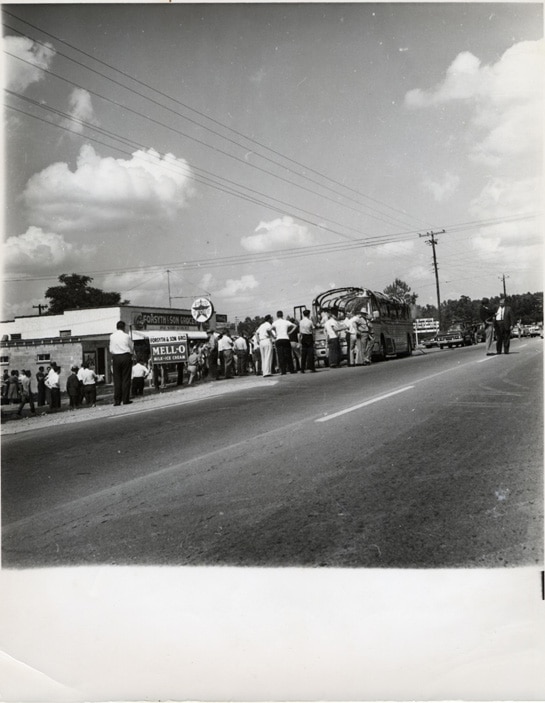
79. A crowd looks at the burned Freedom Riders Bus.
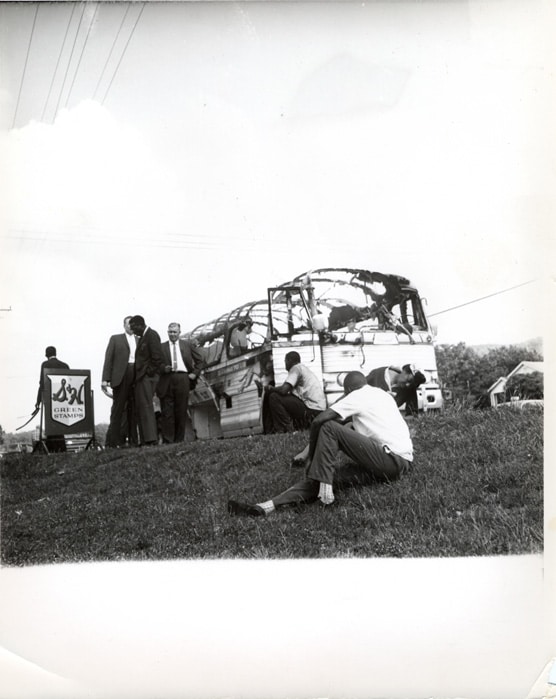
80. Freedom Riders sit on the ground near the remains of their burnt-out bus.
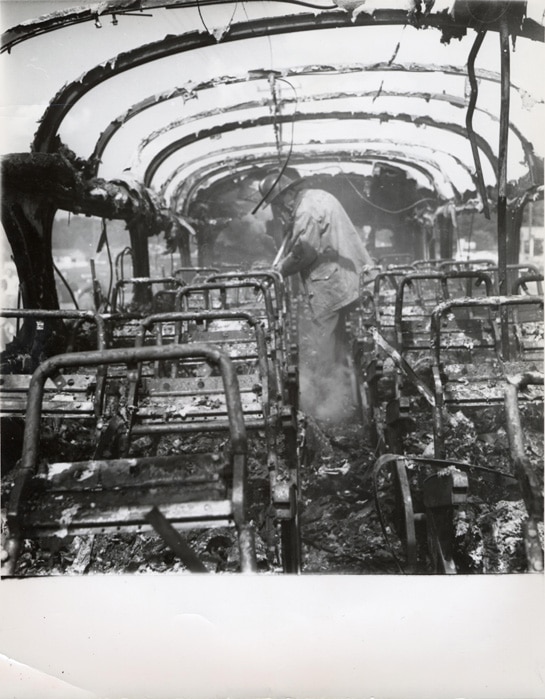
81. A fireman inspects the interior of the destroyed Freedom Riders Bus.
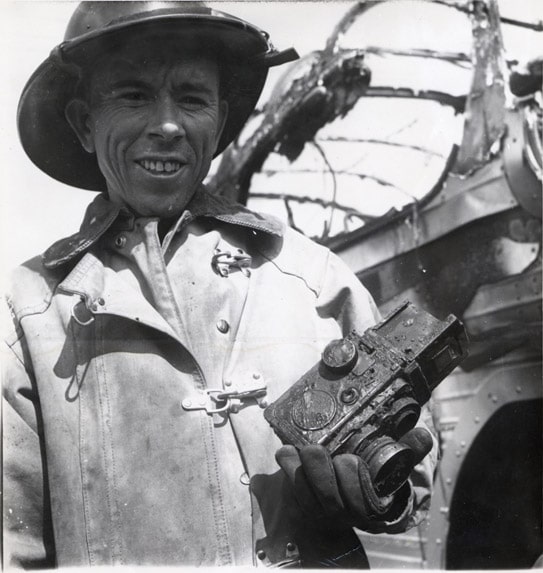
82. A fireman outside the burnt shell of the bus.

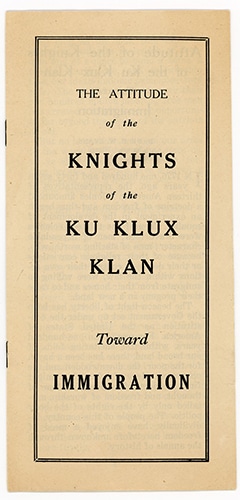
1.The Attitude of the Knights of the Ku Klux Klan Toward Immigration, a brochure by Dr. H. W. Evans, Imperial Wizard of the Knights of the Ku Klux Klan, 1923. Miller Collection. Dallas Holocaust and Human Rights Museum.
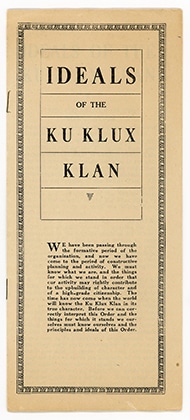
2. Ideals of the Ku Klux Klan, a brochure by Dr. H. W. Evans, Imperial Wizard of the Knights of the Ku Klux Klan, circa 1923. Miller Collection. Dallas Holocaust and Human Rights Museum.
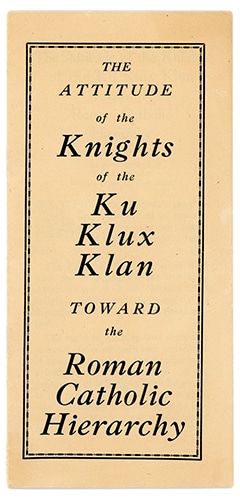
3. The Attitude of the Knights of the Ku Klux Klan Toward the Roman Catholic Hierarchy, a brochure by Dr. H. W. Evans, Imperial Wizard of the Knights of the Ku Klux Klan, 1923. Miller Collection. Dallas Holocaust and Human Rights Museum.
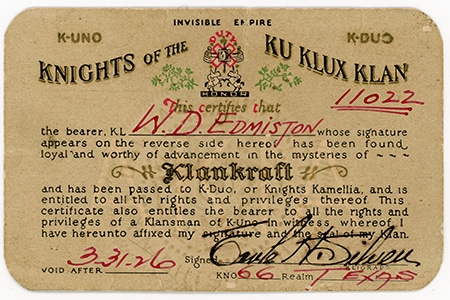
4. Membership card issued to W. D. Edmiston by the Knights of the Ku Klux Klan, Klan No. 66, in Dallas, Texas, March 31, 1926. Miller Collection. Dallas Holocaust and Human Rights Museum.
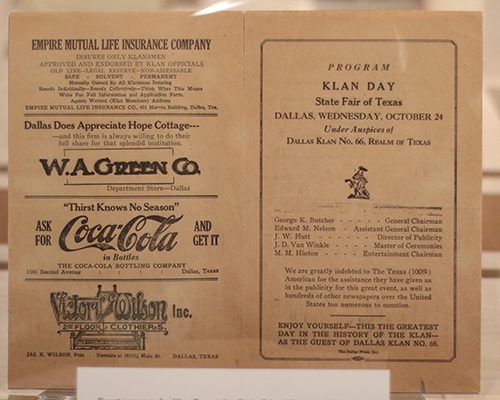
5. Event program for Klan Day at the State Fair of Texas in Dallas, Texas, October 24, 1923. The event featured speakers, sporting events, and a free public initiation. Miller Collection. Dallas Holocaust and Human Rights Museum.
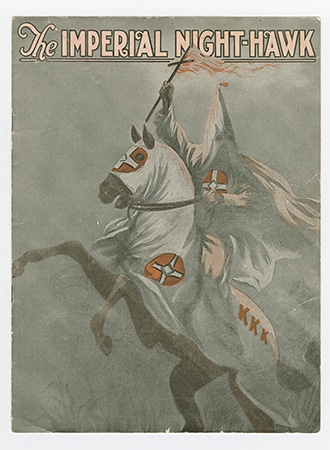
6. The Imperial Night-Hawk, Volume I, No. 20, published in Atlanta, Georgia by the Knights of the Ku Klux Klan, August 29, 1923. Miller Collection. Dallas Holocaust and Human Rights Museum.
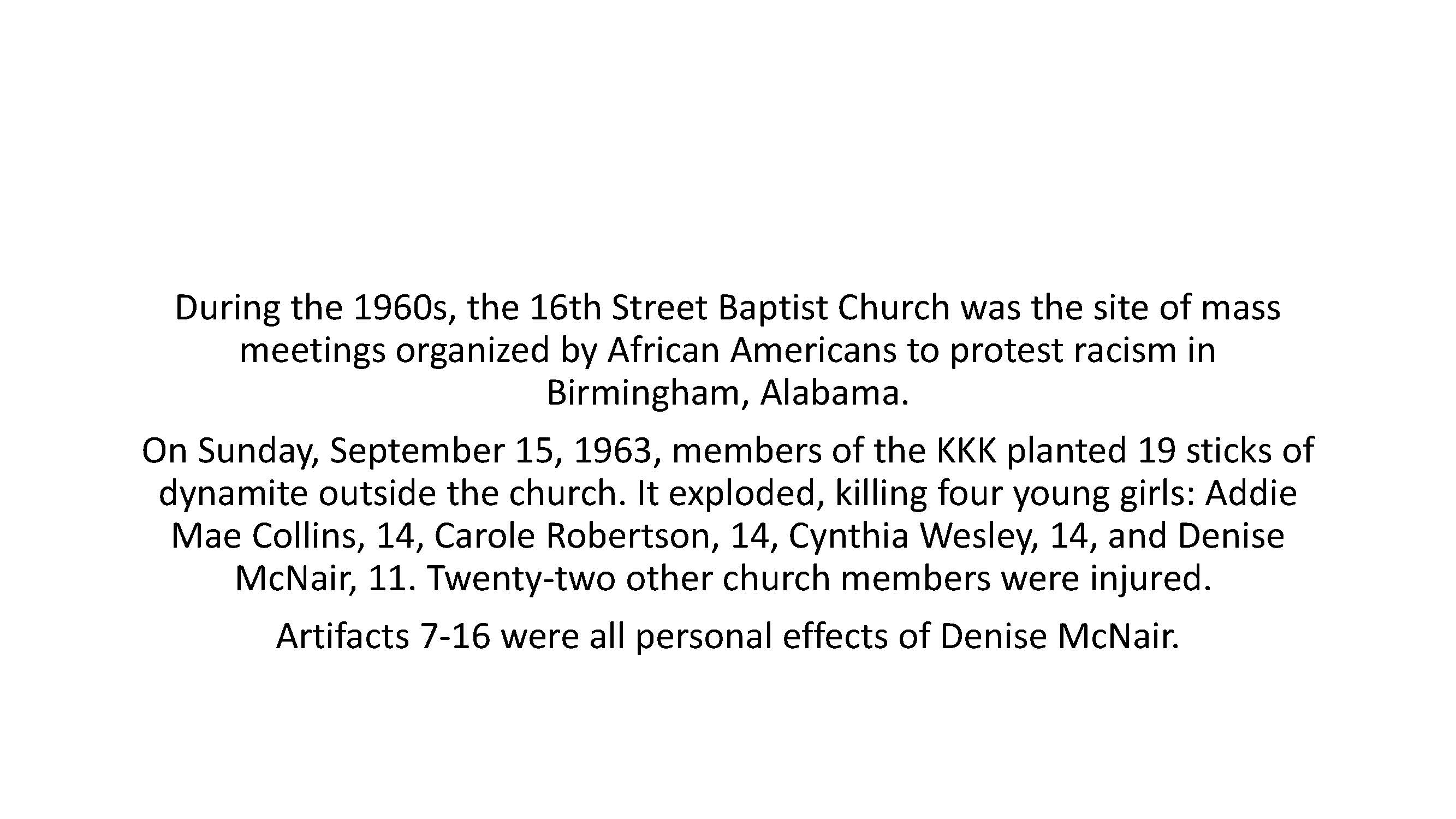
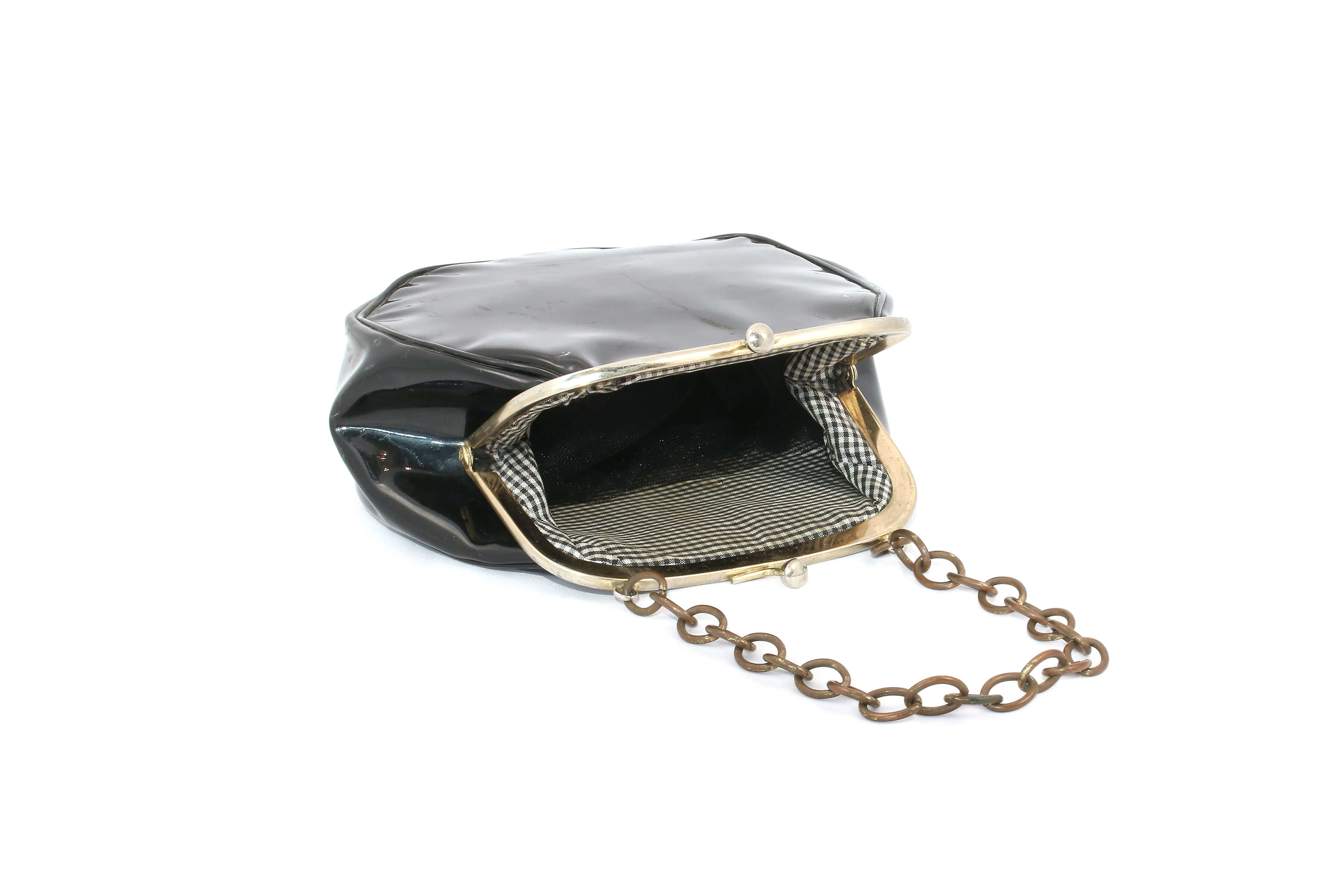
7. Girl's black patent leather purse belonging to Denise McNair, circa 1963. Courtesy of the Birmingham Civil Rights Institute and the Family of Denise McNair.
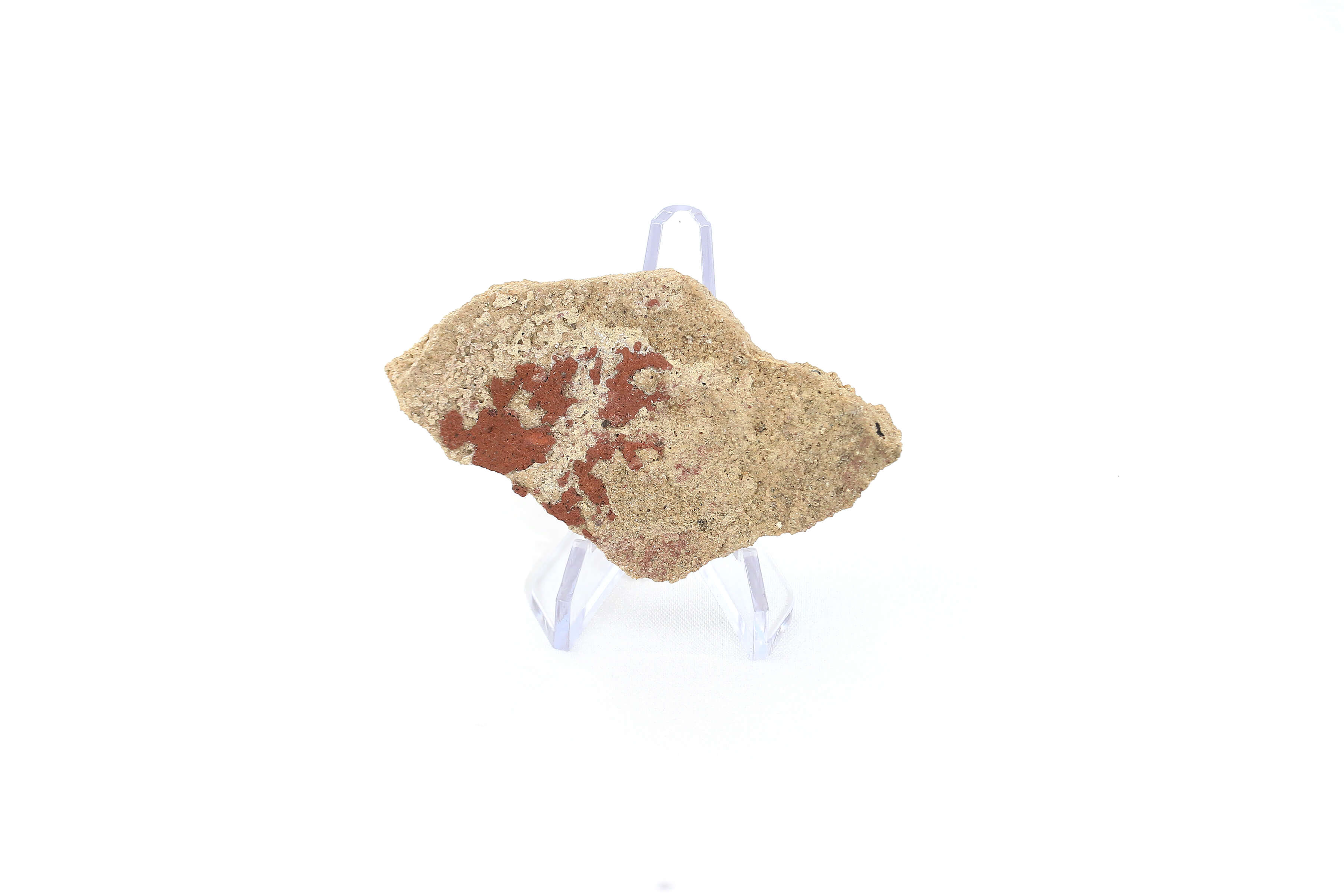
8. Cement brick fragment found at the 16th St. Church Bombing Site, 1963. Courtesy of the Birmingham Civil Rights Institute and the Family of Denise McNair.
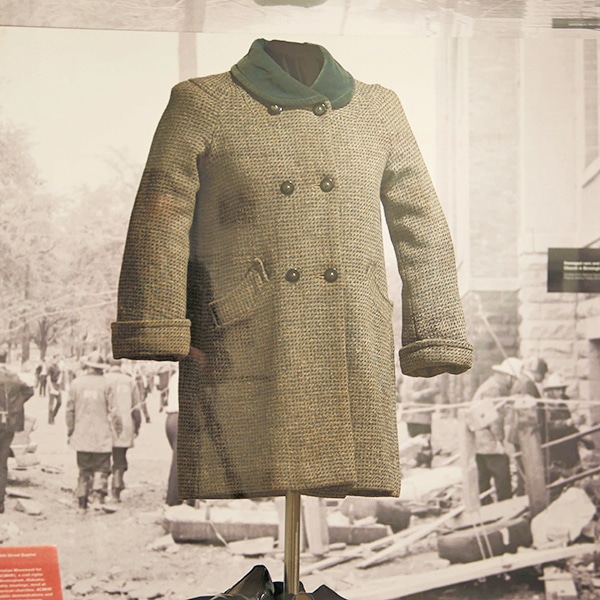
9. Girl's overcoat worn by Denise McNair on the day she died in the bombing of the 16th Street Baptist Church. Courtesy of the Birmingham Civil Rights Institute and the Family of Denise McNair.
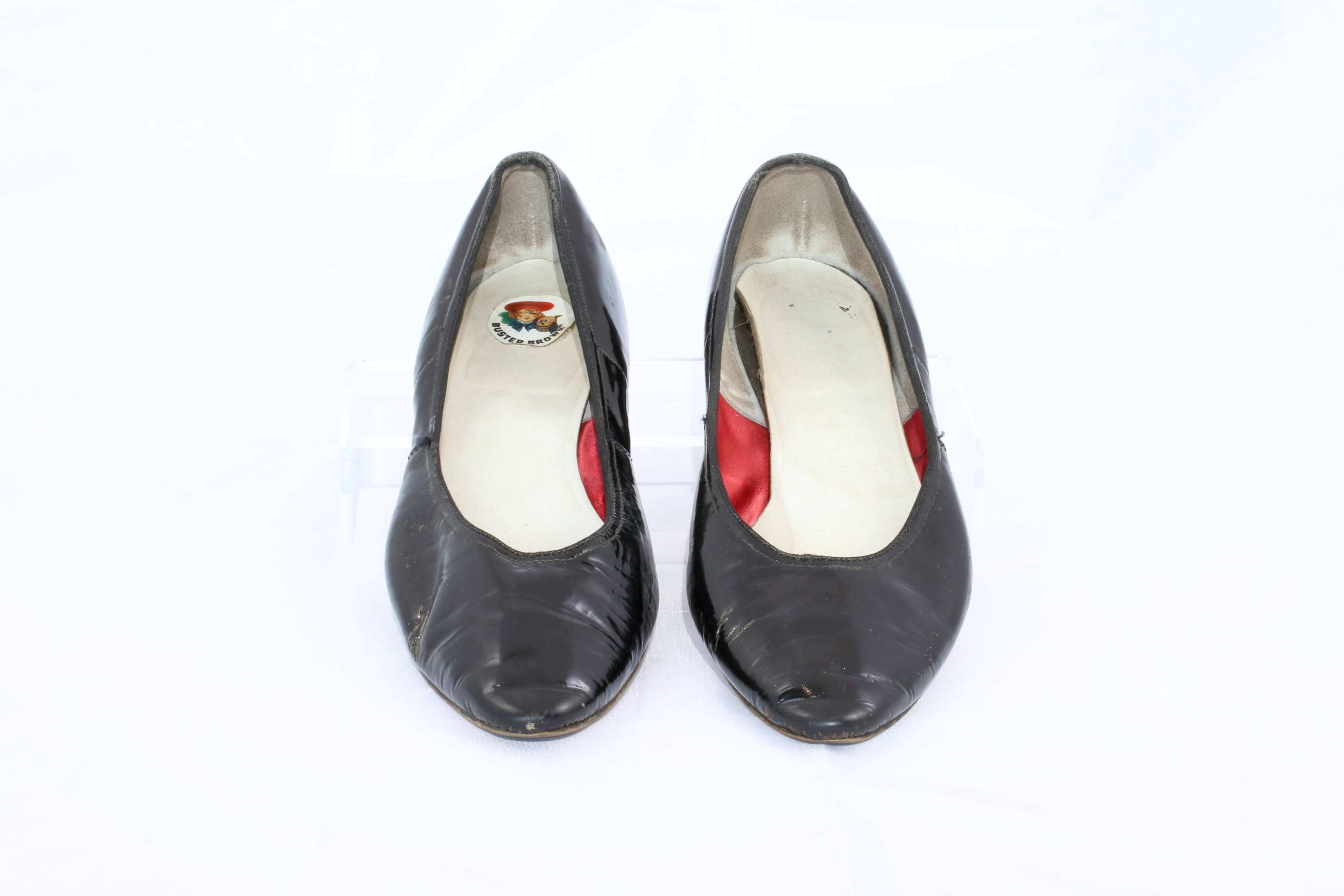
10. Girl's black patent leather shoes worn by Denise McNair on the day she died in the bombing of the 16th Street Baptist Church. Courtesy of the Birmingham Civil Rights Institute and the Family of Denise McNair.
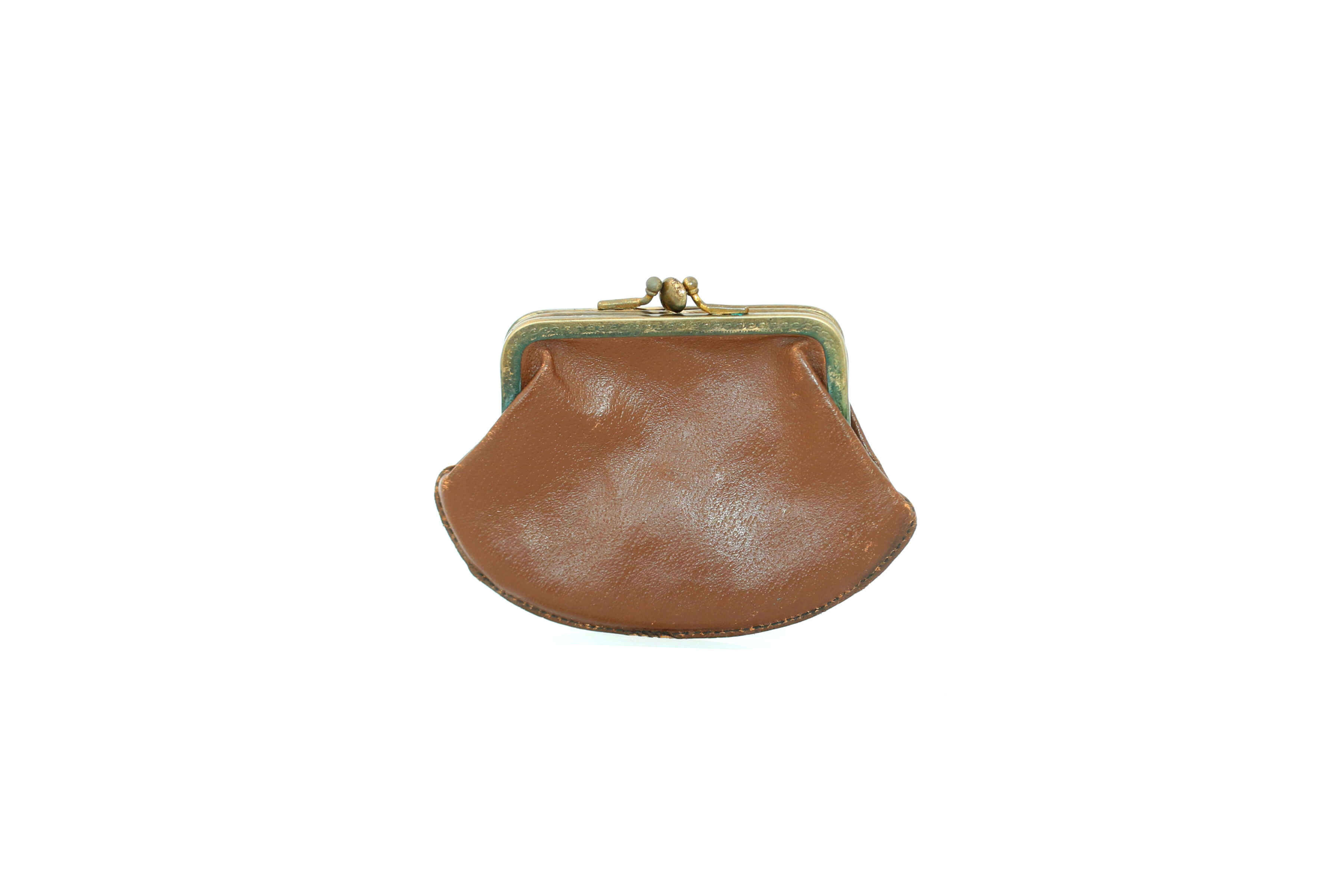
11. Denise McNair's personal effects, circa 1963. Girl's brown leather coin purse. Courtesy of the Birmingham Civil Rights Institute and the Family of Denise McNair.
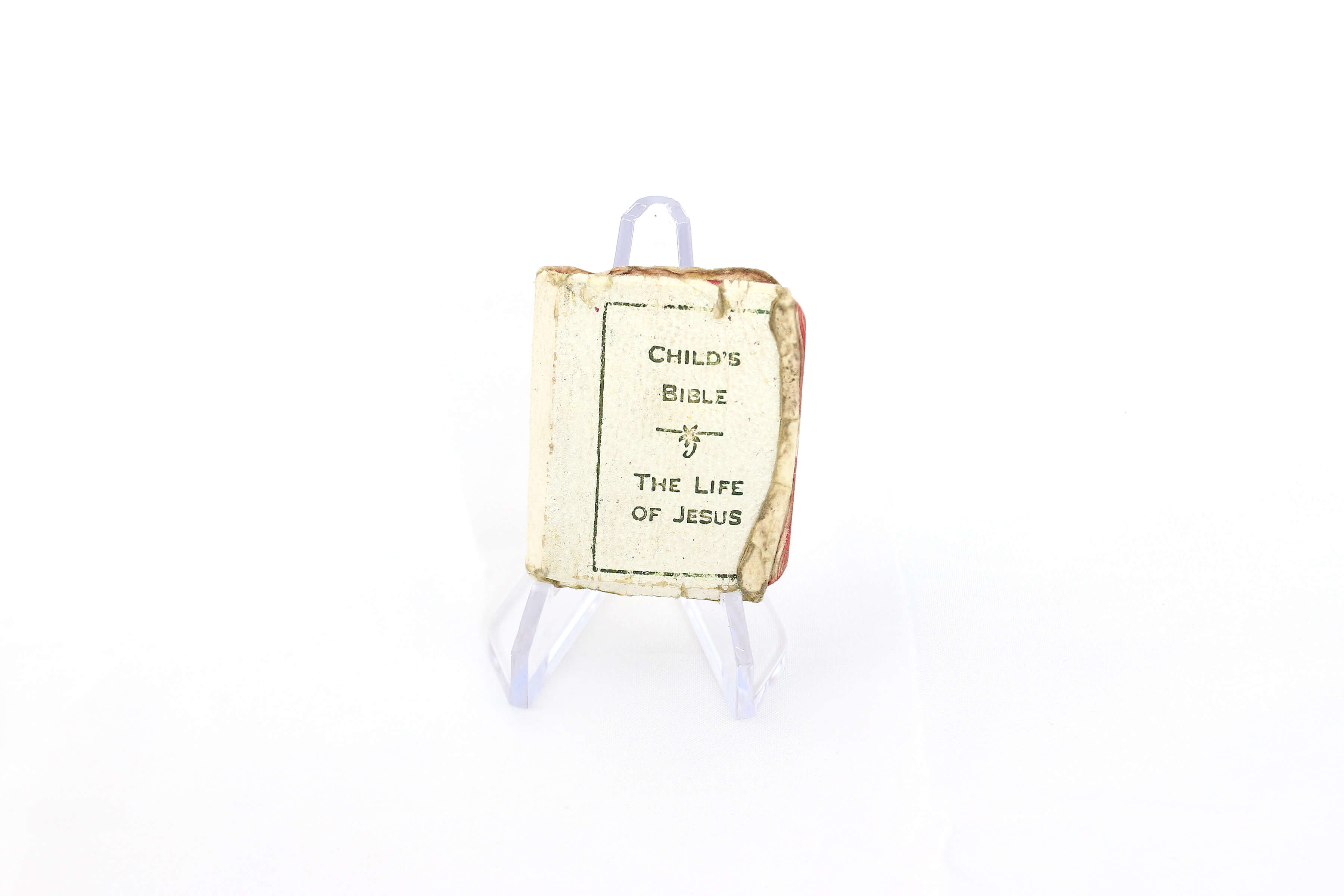
12. Denise McNair's personal effects, circa 1963. Child's Bible. Courtesy of the Birmingham Civil Rights Institute and the Family of Denise McNair.

13. Denise McNair's personal effects, circa 1963. Broken lead pencil. Courtesy of the Birmingham Civil Rights Institute and the Family of Denise McNair.
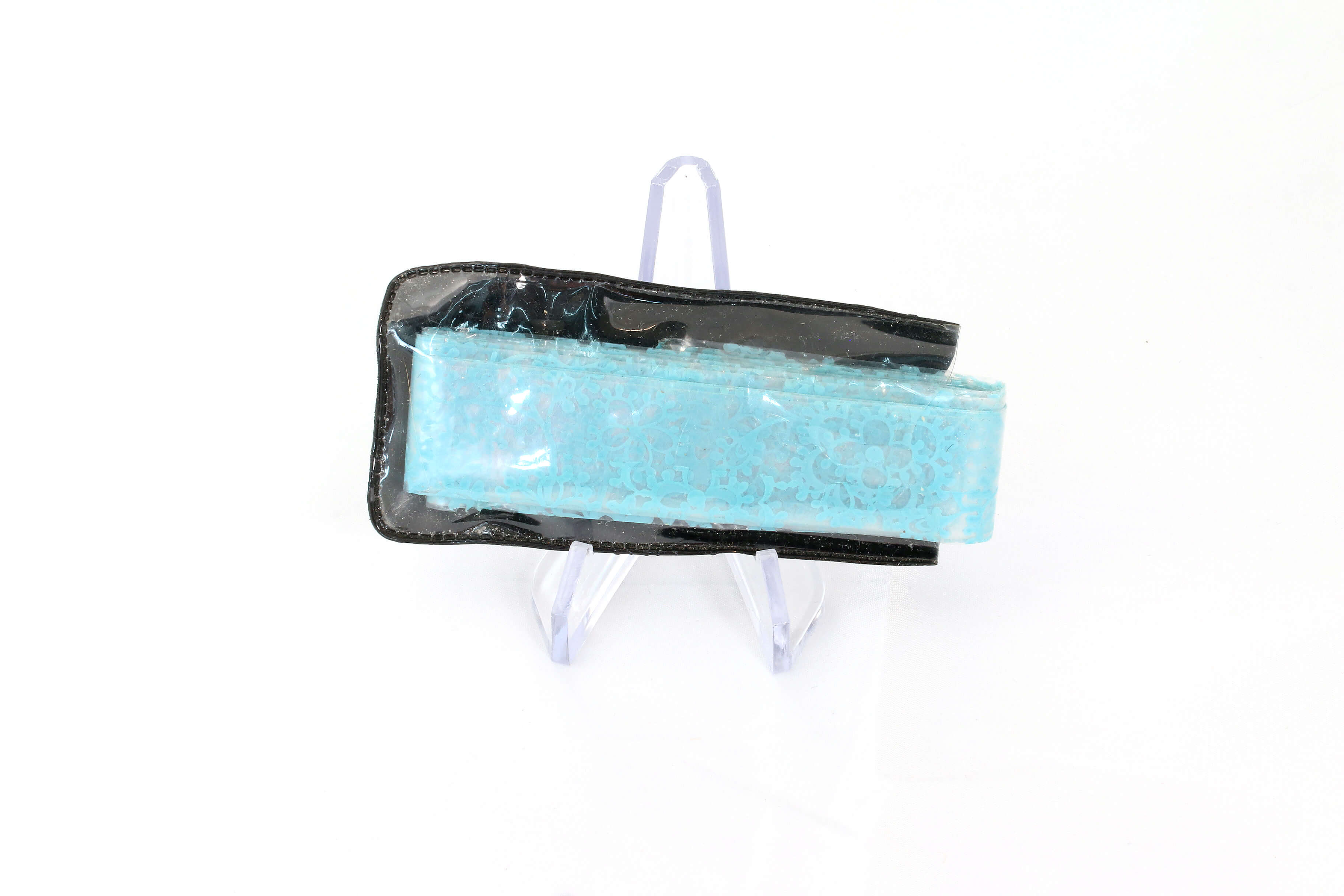
14. Denise McNair's personal effects, circa 1963. Plastic bonnet. Courtesy of the Birmingham Civil Rights Institute and the Family of Denise McNair.
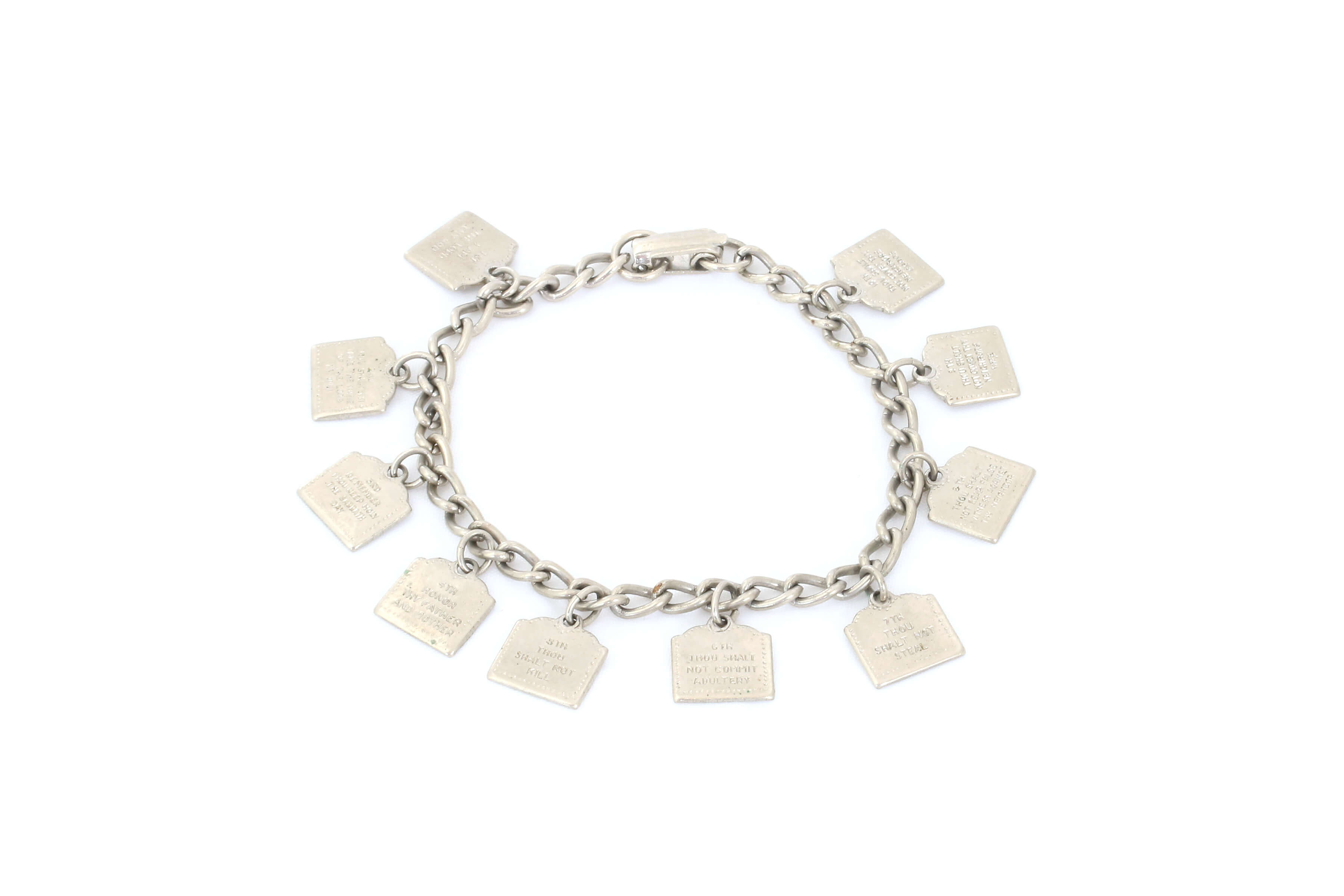
15. Denise McNair's personal effects, circa 1963. Silver bracelet with 10 Commandments on individual charms. Courtesy of the Birmingham Civil Rights Institute and the Family of Denise McNair.
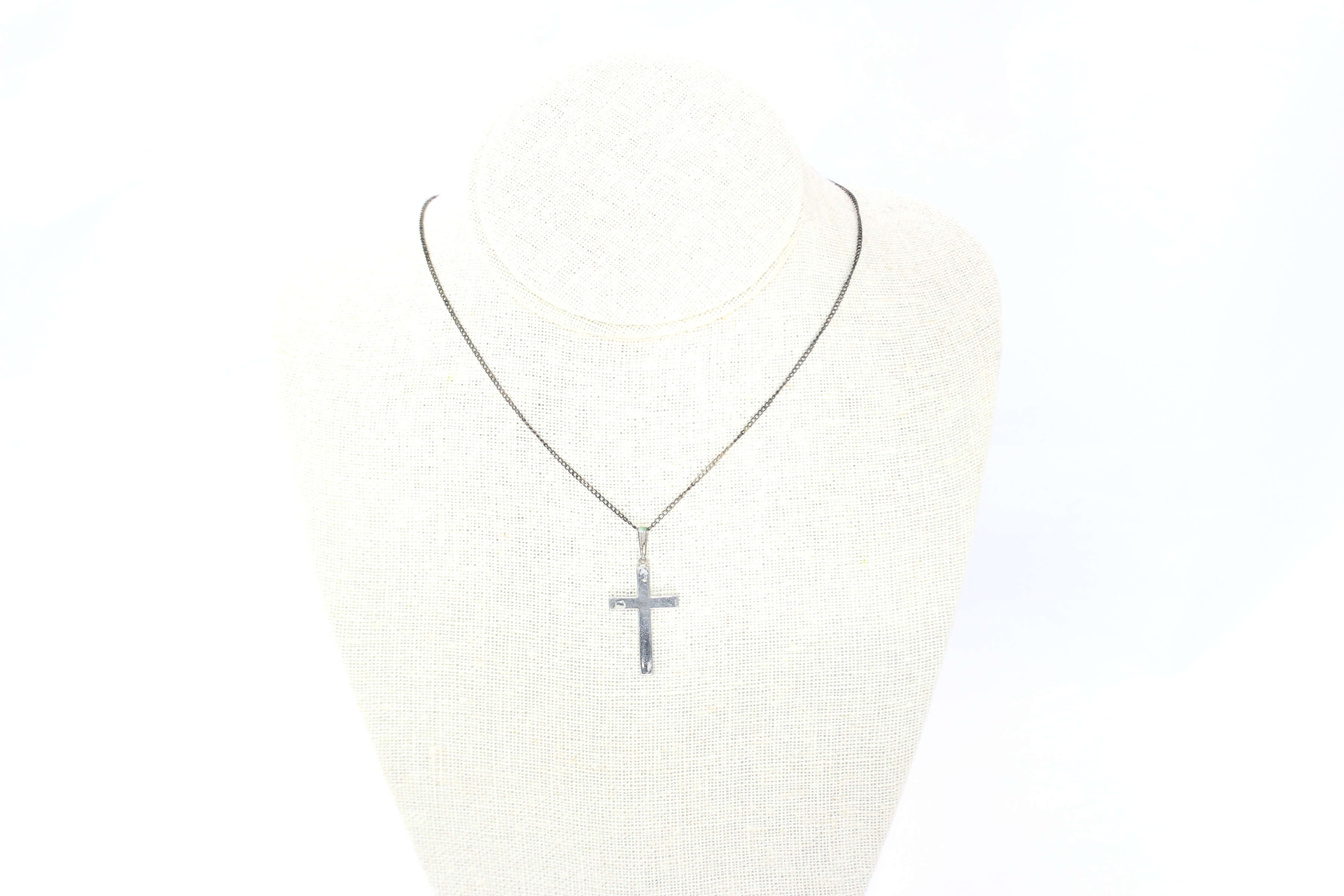
16. Denise McNair's personal effects, circa 1963. Girl's silver necklace with silver crucifix. Courtesy of the Birmingham Civil Rights Institute and the Family of Denise McNair.
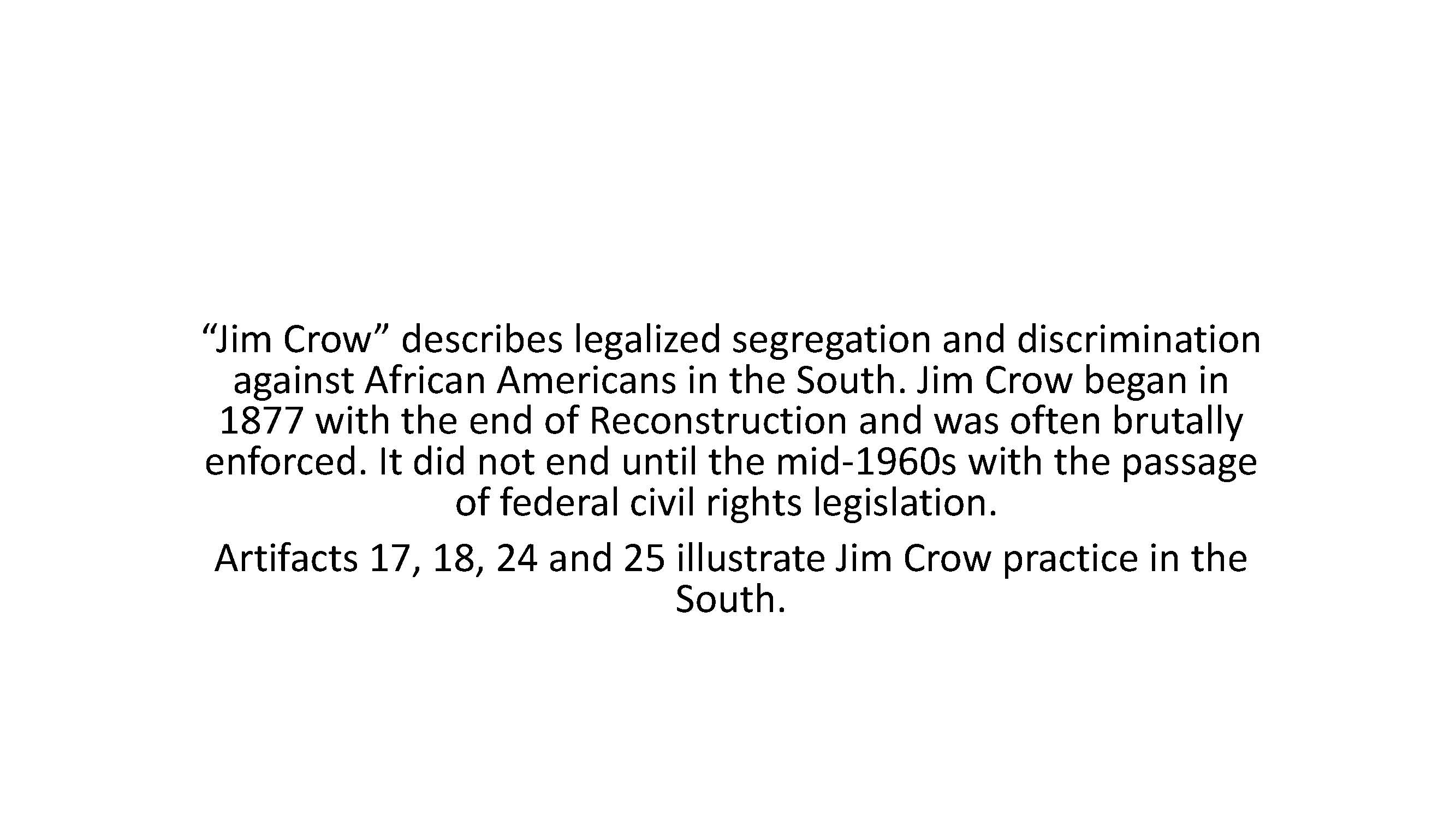

17. Physician's waiting room sign. Courtesy of the Birmingham Civil Rights Institute.
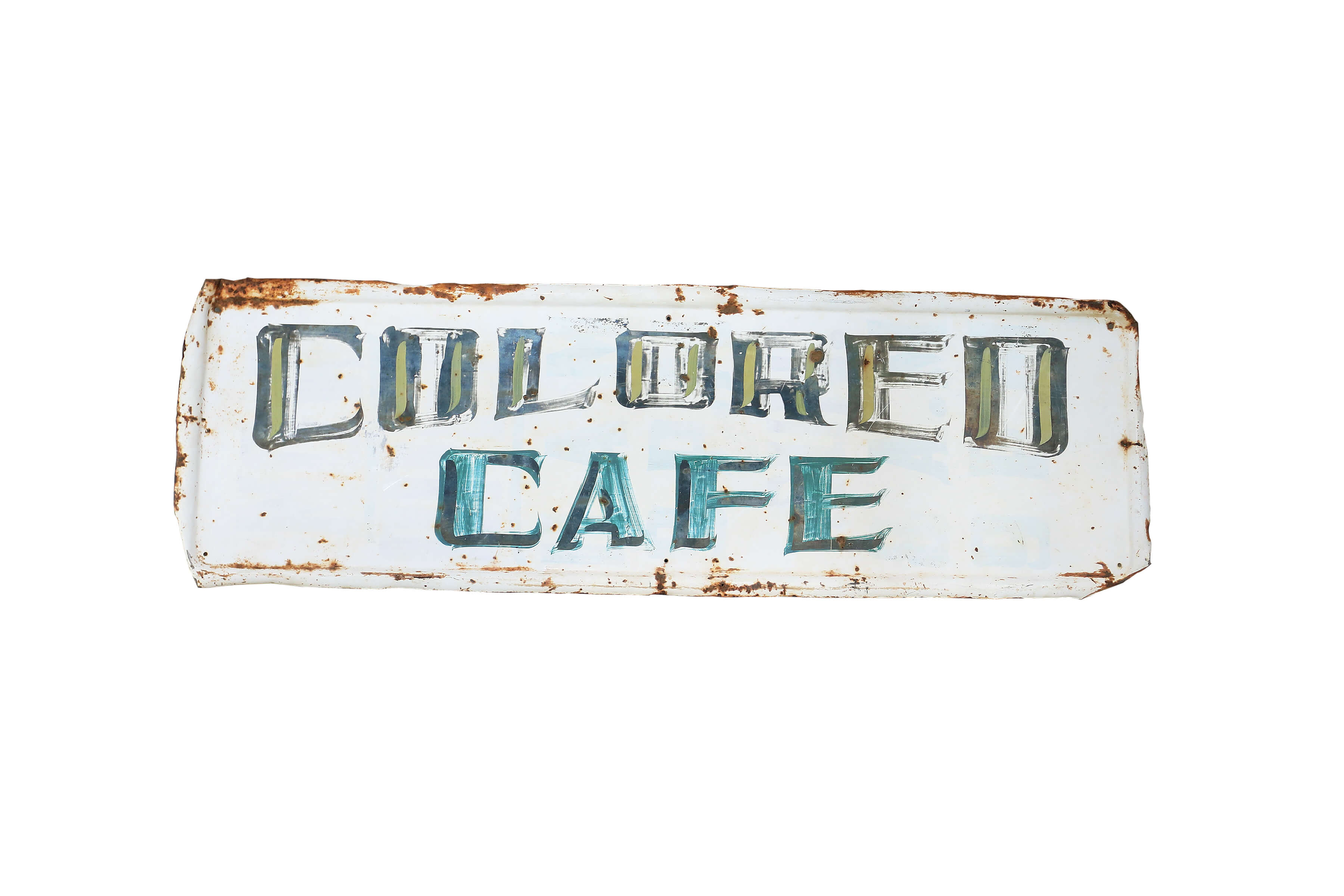
18. Colored cafè sign. Courtesy of the Birmingham Civil Rights Institute.
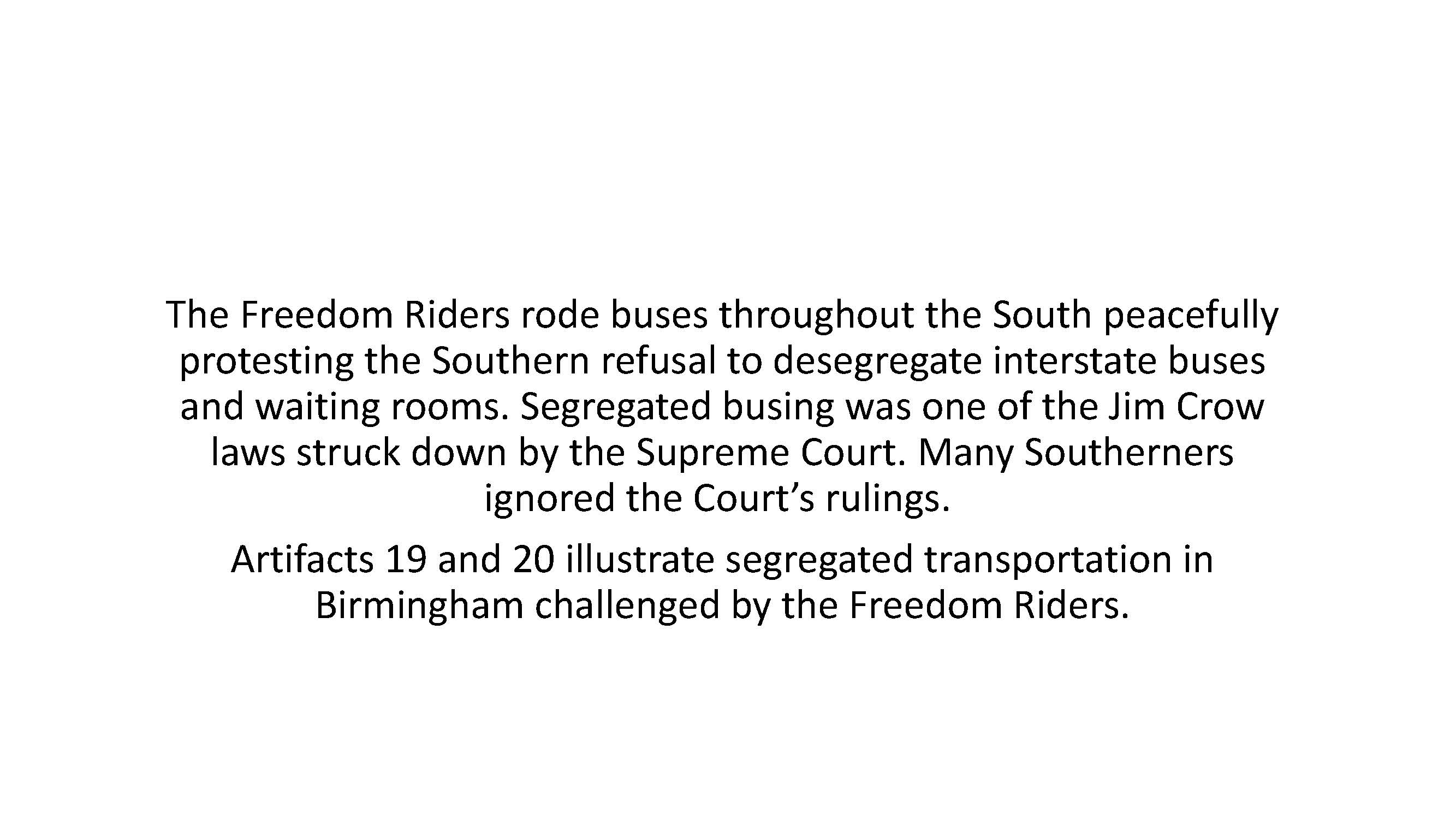
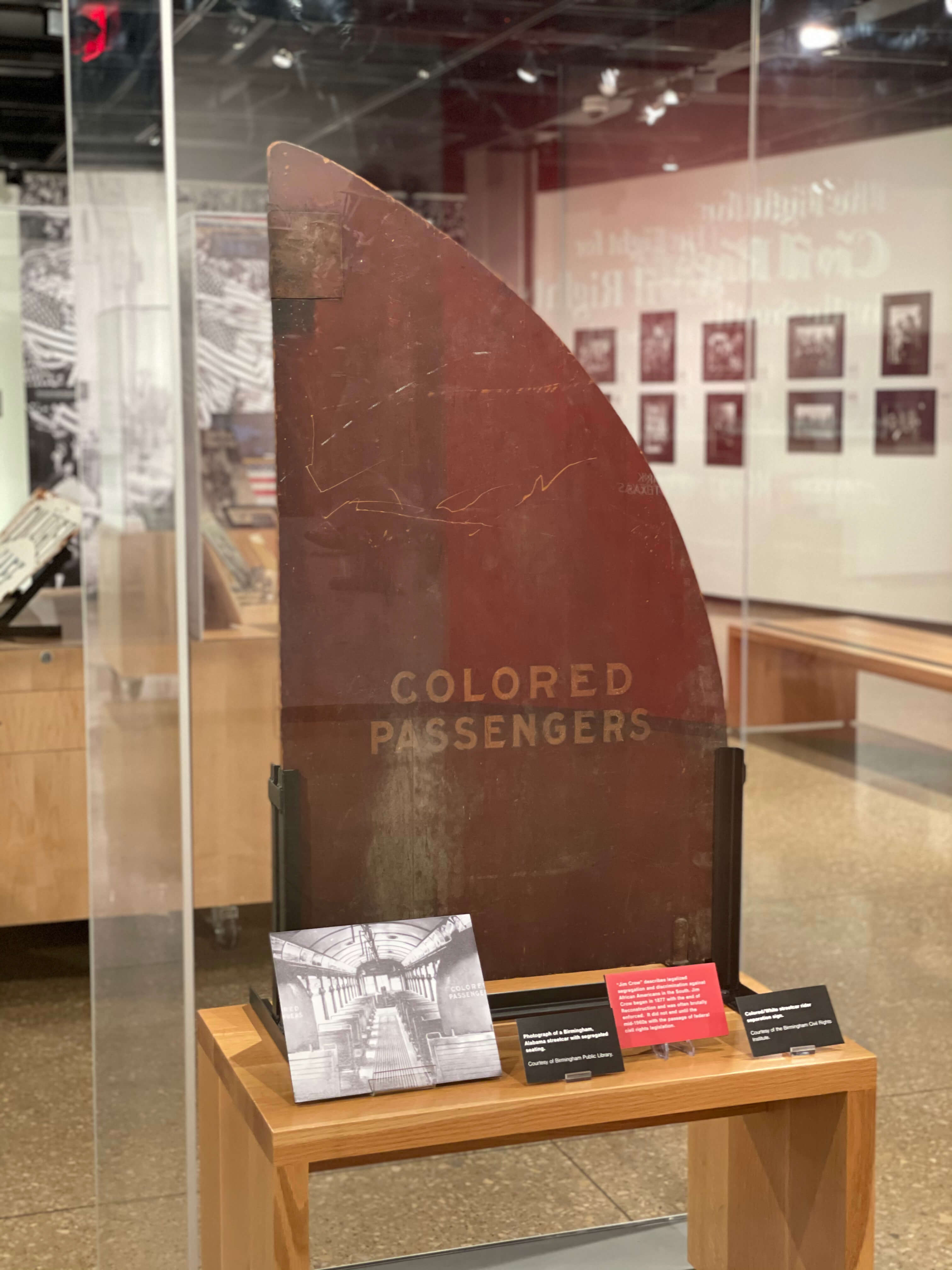
19. Colored/White streetcar rider separation sign. Courtesy of the Birmingham Civil Rights Institute.
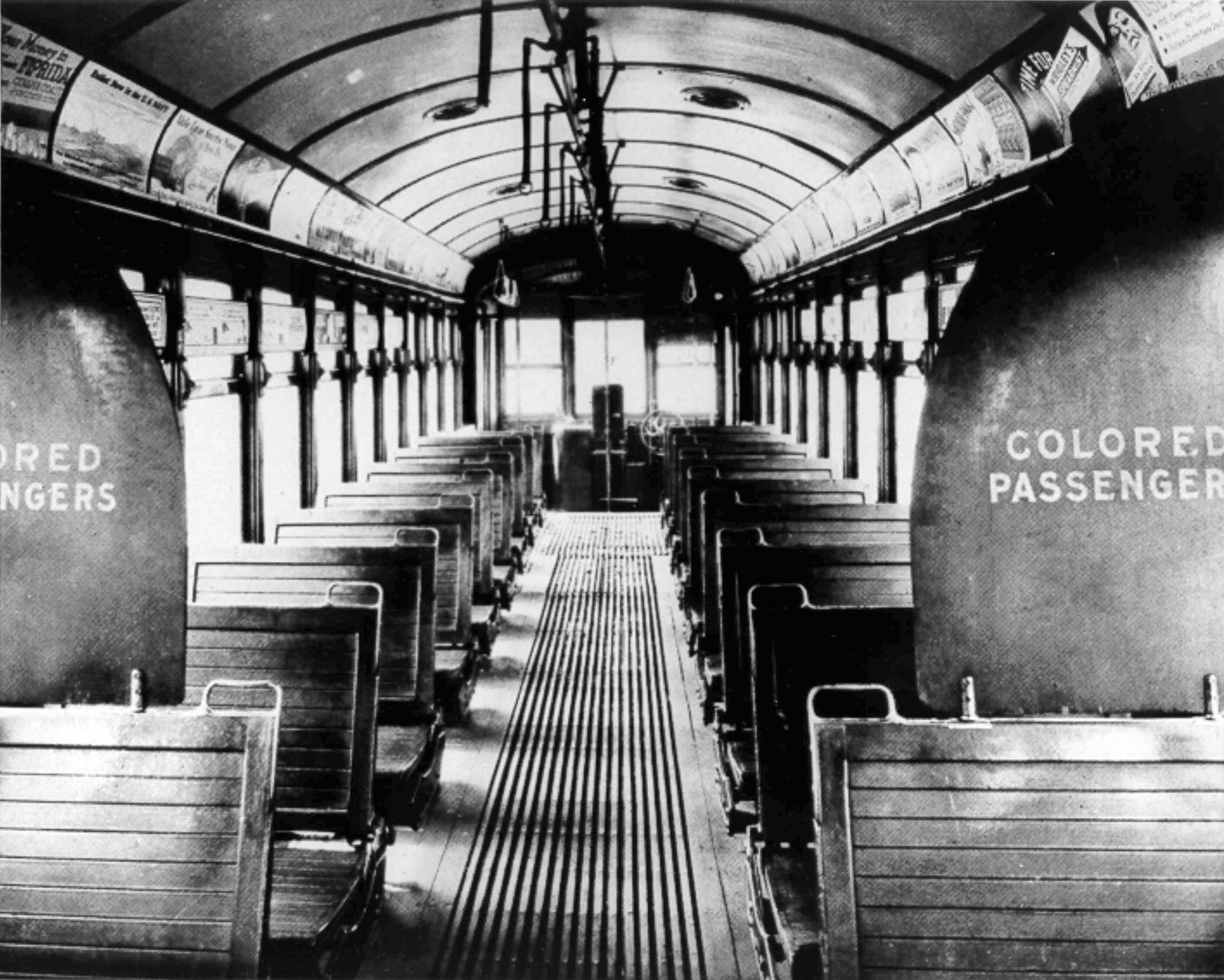
20. Photograph of a Birmingham, Alabama streetcar with segregated seating. Courtesy of Birmingham Public Library.
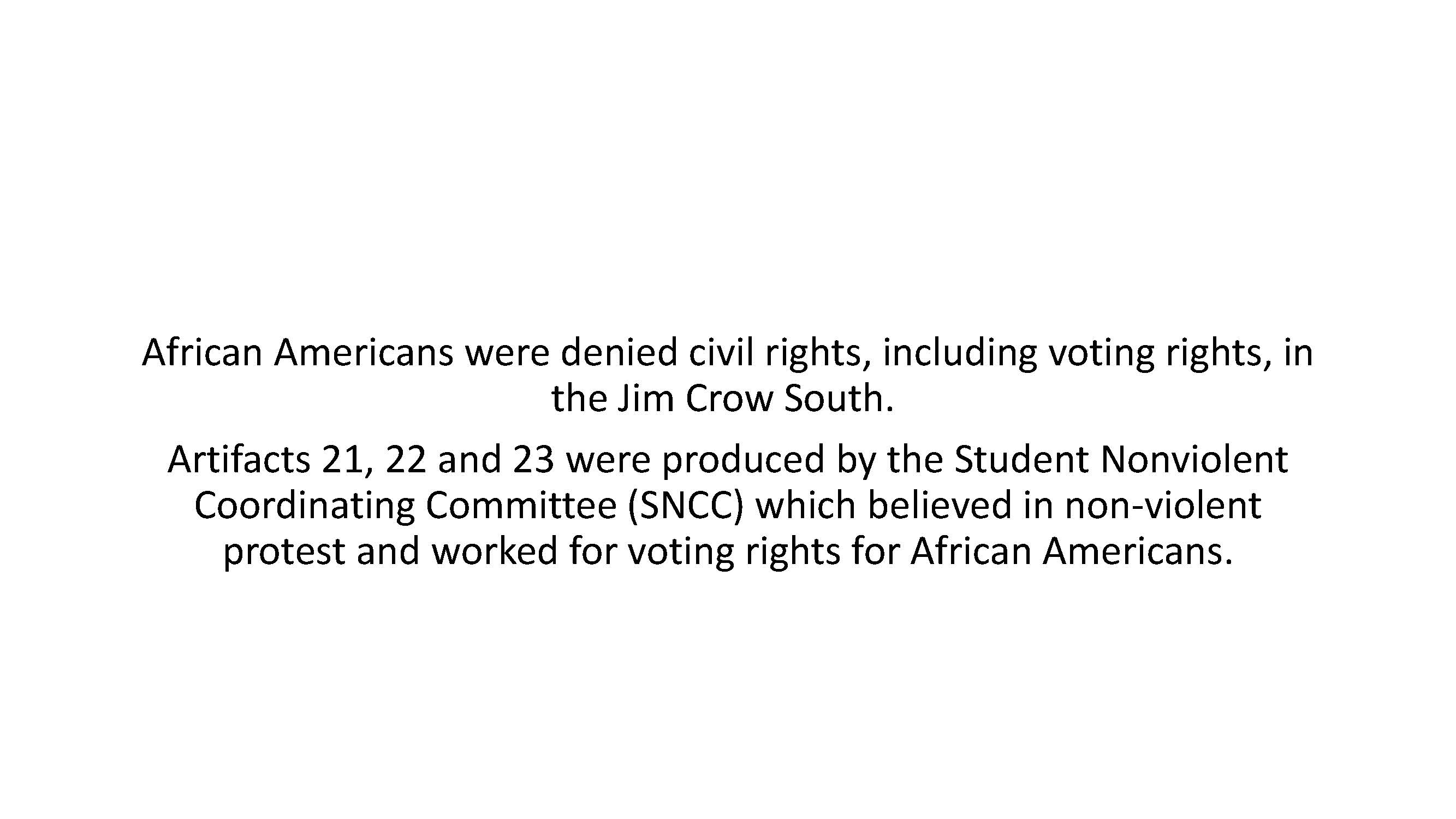
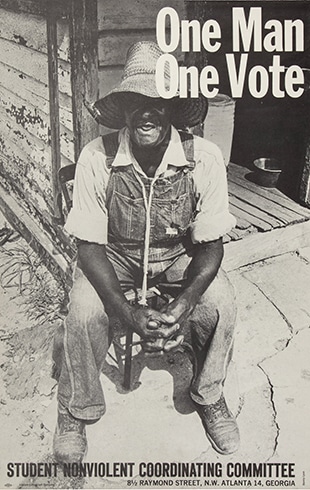
21. "One Man, One Vote" Student Nonviolent Coordinating Committee poster, 1964. Courtesy of Special Collections, University of North Texas Libraries.
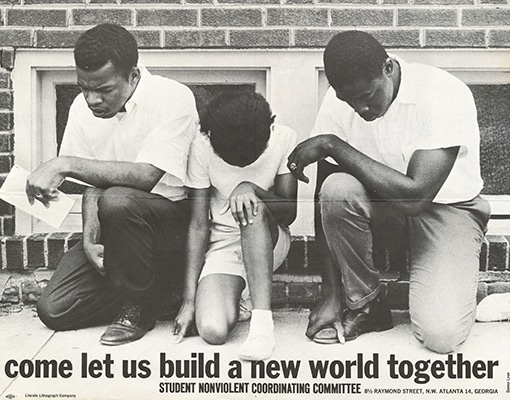
22. "Come let us build a new world together" Student Nonviolent Coordinating Committee poster, 1963. Courtesy of Special Collections, University of North Texas Libraries.

23. "Now" Student Nonviolent Coordinating Committee poster, 1963. Courtesy of Special Collections, University of North Texas Libraries.

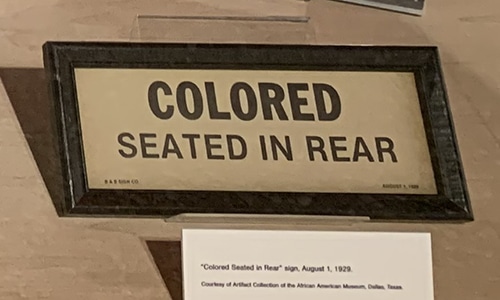
24. "Colored Seated in Rear" sign, August 1, 1929. Courtesy of the African American Museum of Dallas."
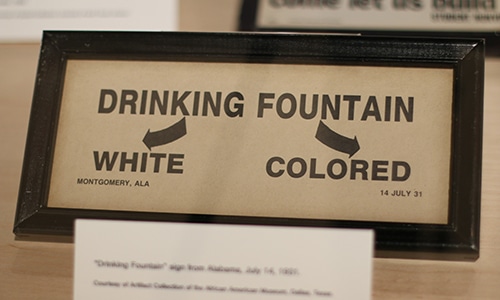
25. "Drinking Fountain" sign, July 14, 1931. Courtesy of the African American Museum of Dallas.
SPONSORS
Presented by

Supported by

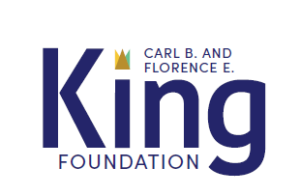
Exhibition Sponsors




African American Forum | Minority Men Affinity Network
Employee Resource Groups at State Farm®
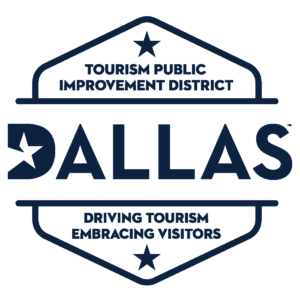

Hotel Sponsor

COMMUNITY PARTNERS
African American Museum of Dallas
Anti-Defamation League Texoma
Big Brothers Big Sisters
Congregation Anshai Torah
Dallas Truth, Racial Healing & Transformation
Denton Black Film Festival
Grant Halliburton Foundation
The Legacy Senior Communities
Refugee Services of Texas, Inc.
SMU Human Rights Program
Vickery Meadows Youth Development Foundation
WiNGS
World Affairs Council of Dallas/Fort Worth
An Immersive, Interactive Journey Unlike Any Other
Please join us for a visit. Unforgettable doesn't begin to describe the experience.
